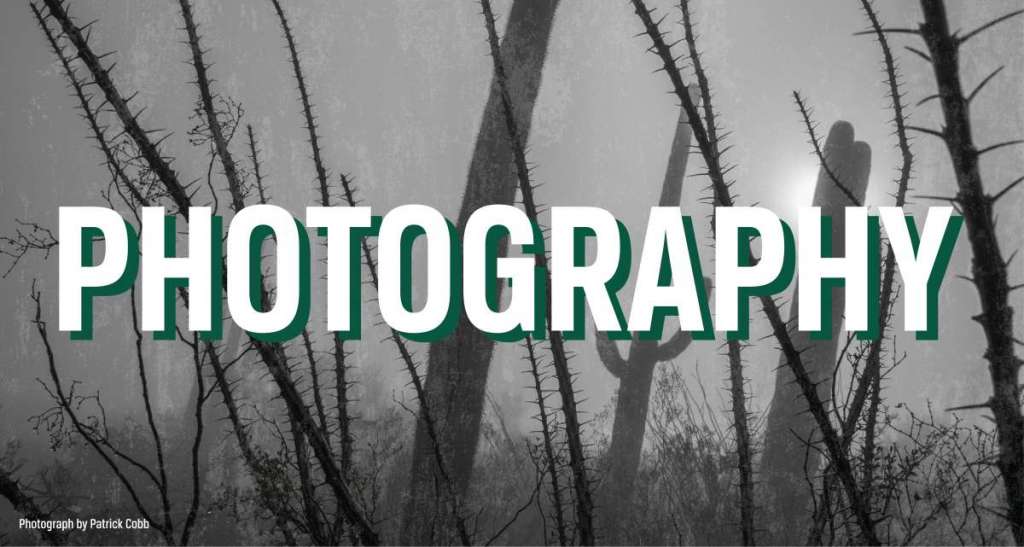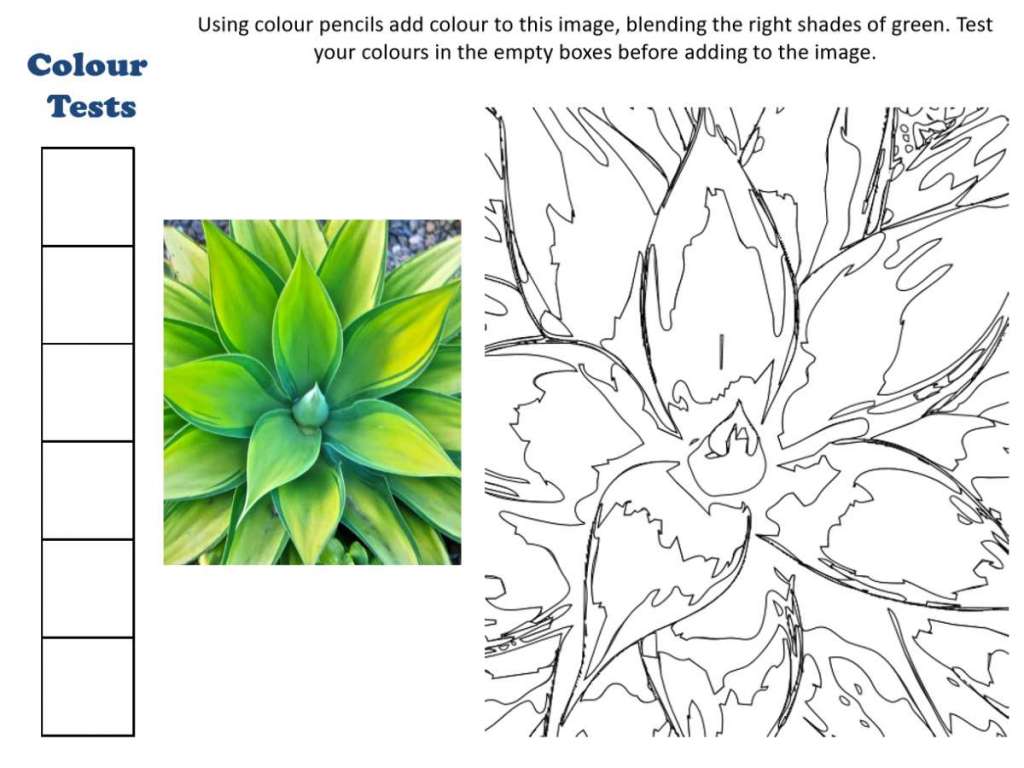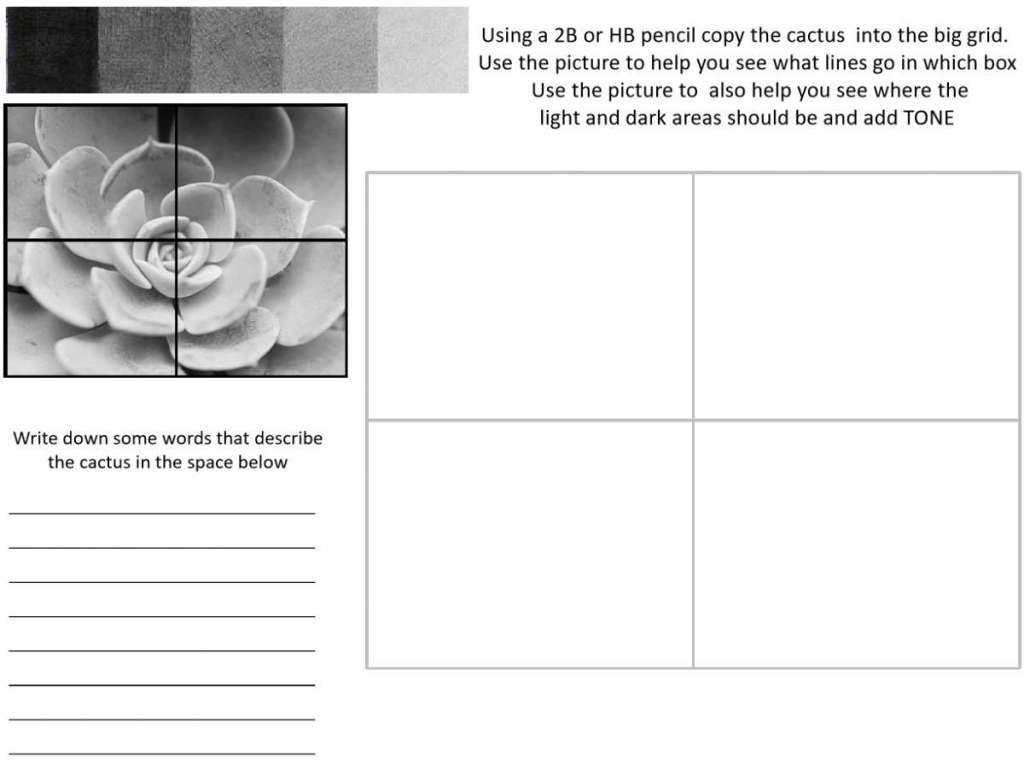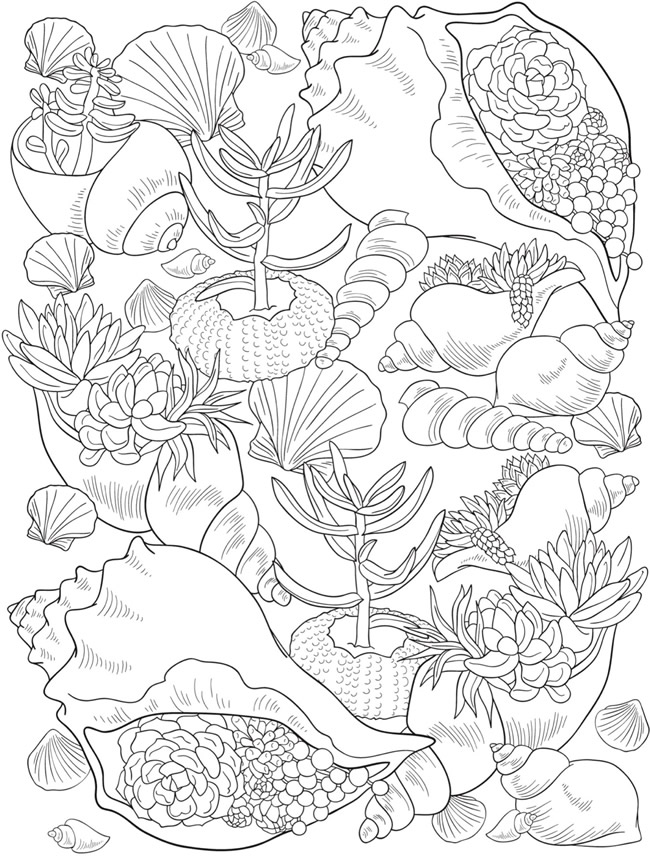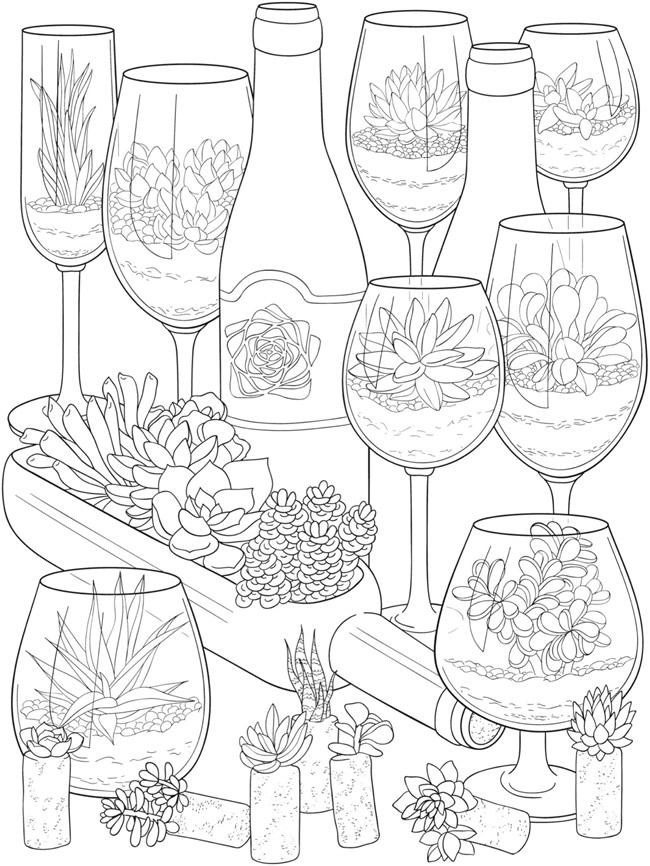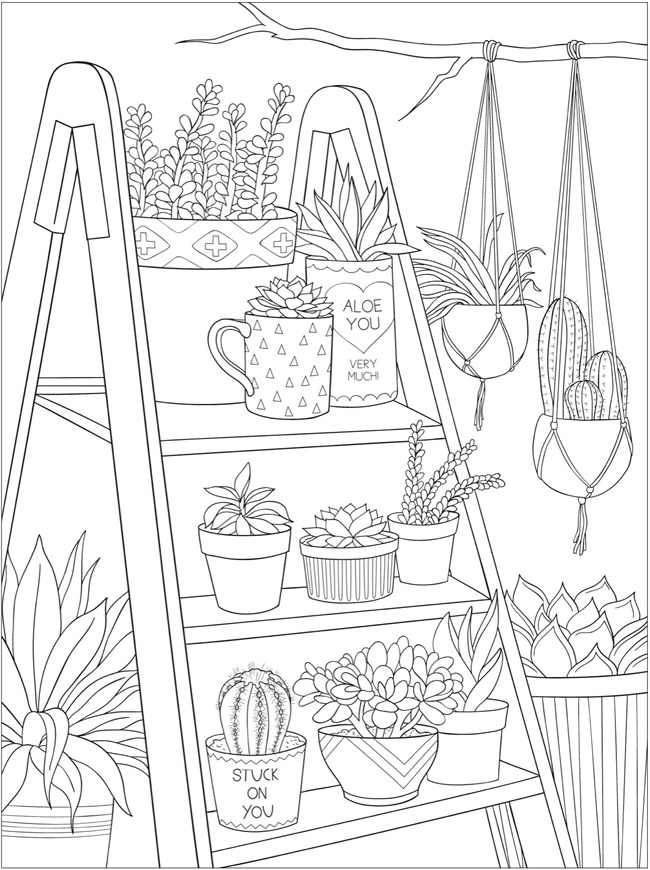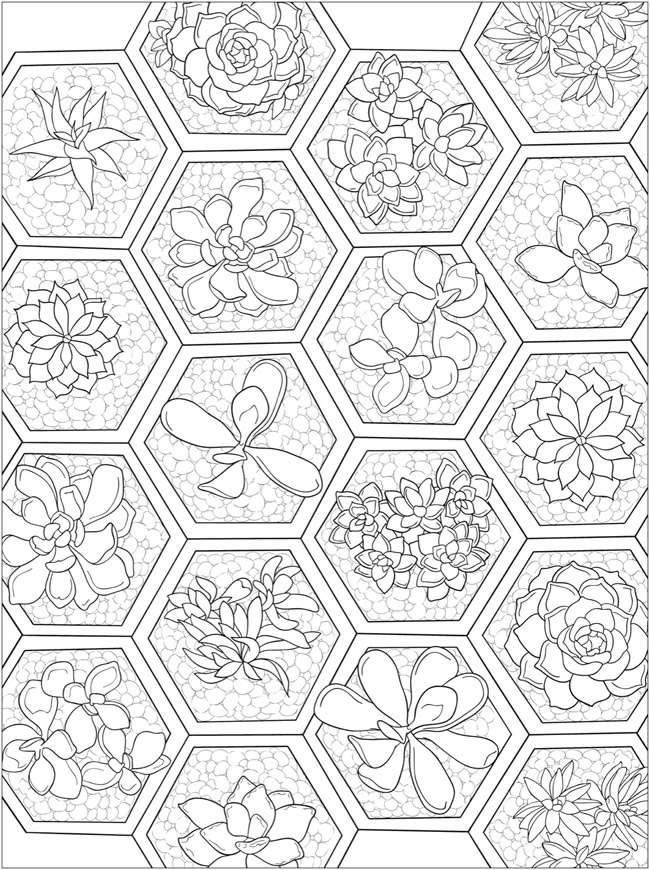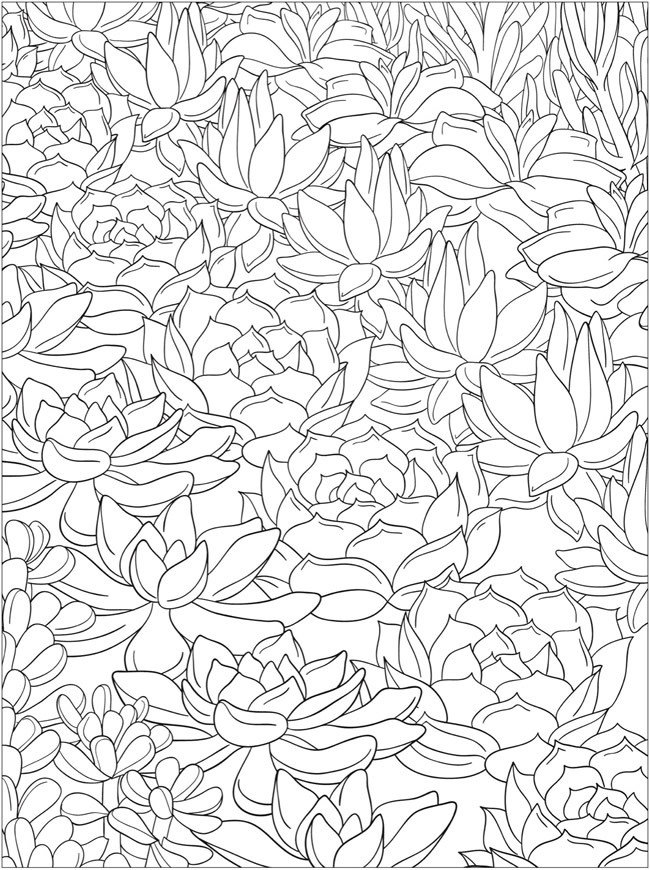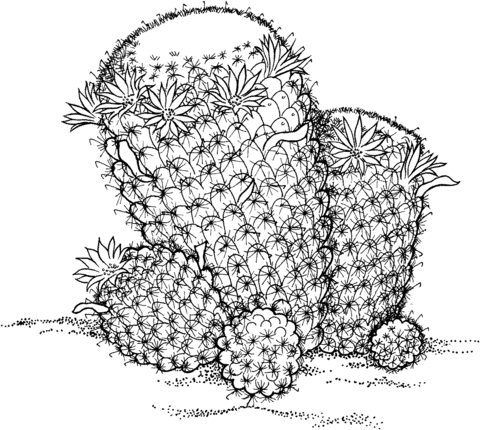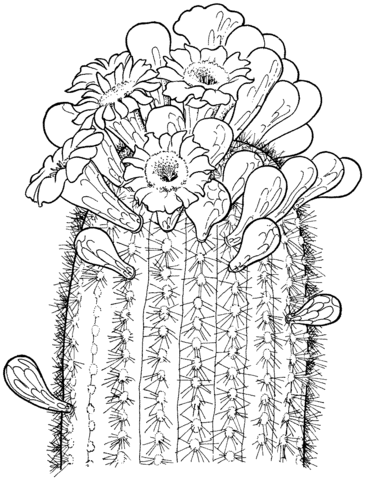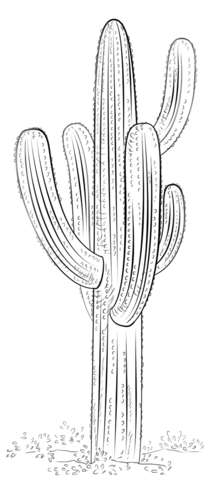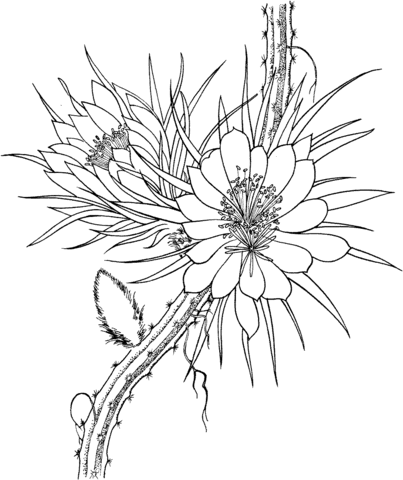Succulent Succulence
Juiciness, moistness, lusciousness are synonyms for succulence and they describe this adaptive strategy to a “T,” though likely not the words Johann Bauhin had in mind in 1619 when he first used the term to describe plants with thick leaves. As a mechanism for survival, succulence allows plants to withstand temporary water shortages by storing moisture in their stems, roots or leaves. Sounds perfect for plants that grow here in the Sonoran Desert, yes?
Examples of succulent plants include our native cacti, agaves, yuccas, even ocotillos which are “semi-succulent.” It also applies to that broad grouping of soft leaved, spineless plants we refer to as “succulents” – echeverias, sedums, crassulas, etc. – native to the Americas and other dry places like Africa and even the Mediterranean.
So, whether an adaptive strategy or the darling of dish gardeners, succulence and succulents are a positive, cooling response to our desert heat.
Day 1 – Getting Started
What Is A Succulent?
World’s Most Spectacular Plants
30+ Cacti Identifications
The Survival of the Fattest
Learn How To Identify
Online Guide
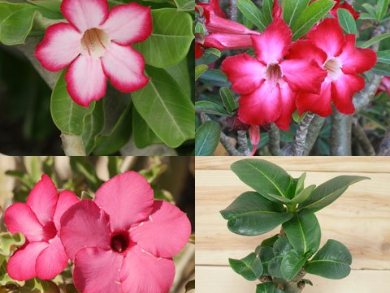
Cactus Name Search
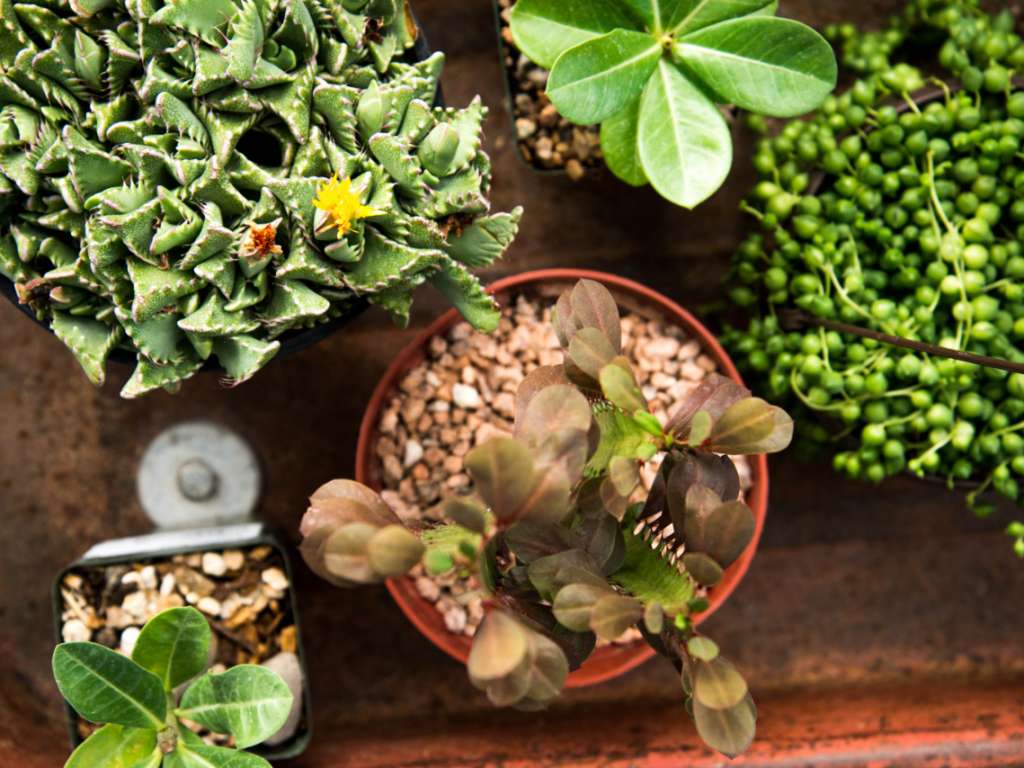
PlantSnap – Identification App
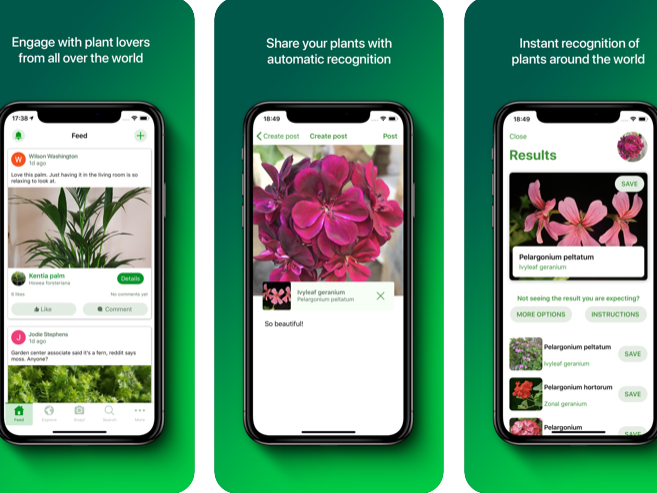
Excellent E-Books, Download For Free
Cactus Culture: For Amateurs

The Complete Book of Cacti & Succulents
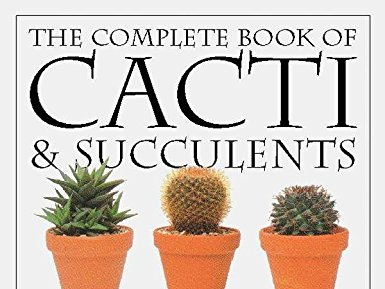
At Home with Succulents
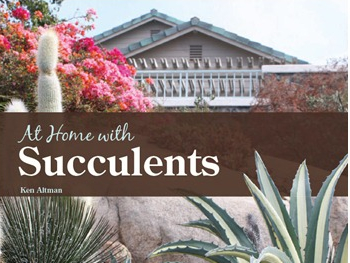
Idiot’s Guide To Succulents
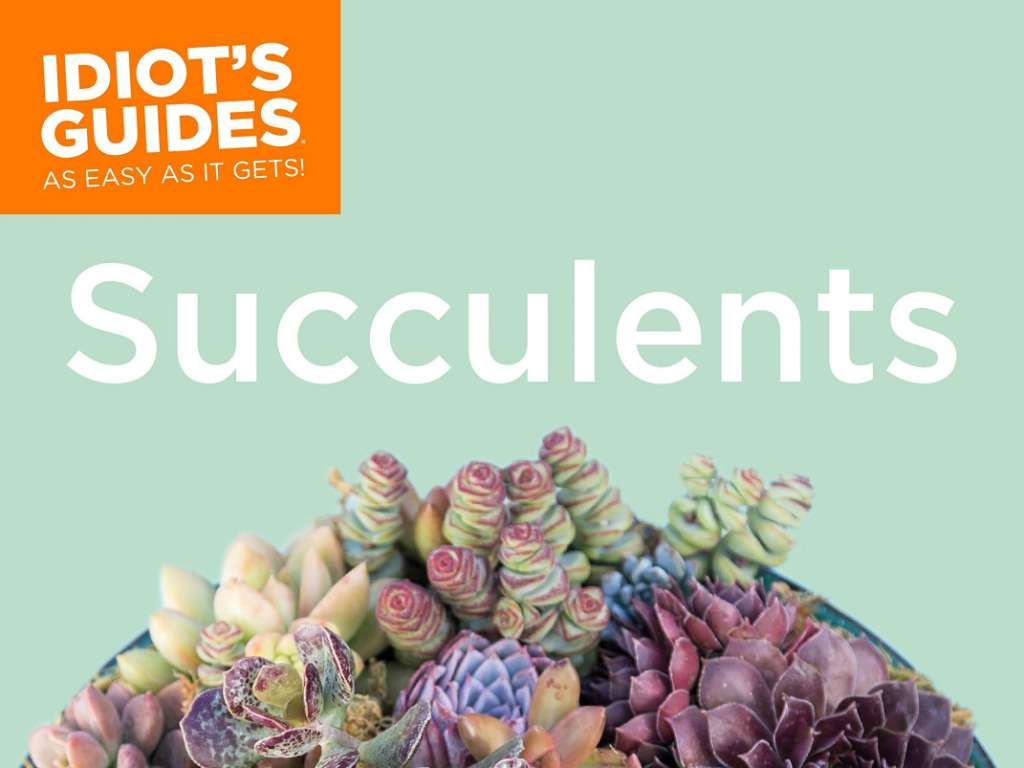
Succuholics 101
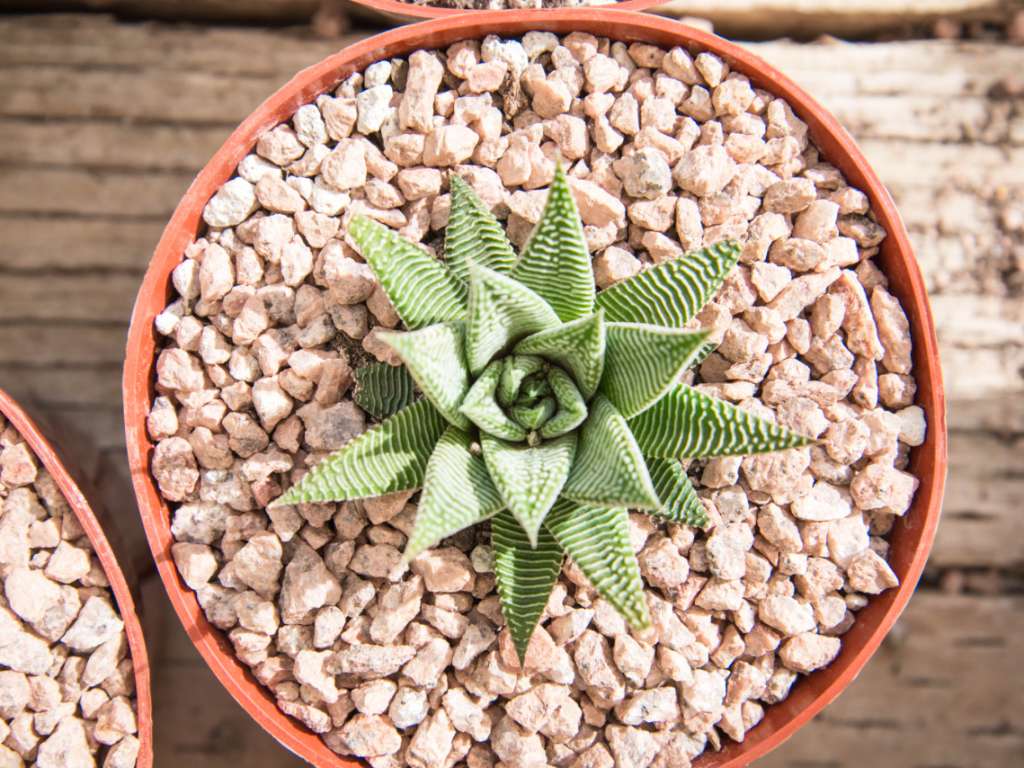
Getting Started with Succulents
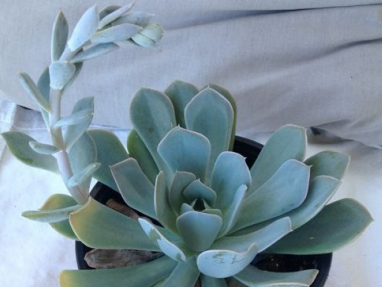
Beautiful Botanicals
Botanical Art of the Sonoran Desert
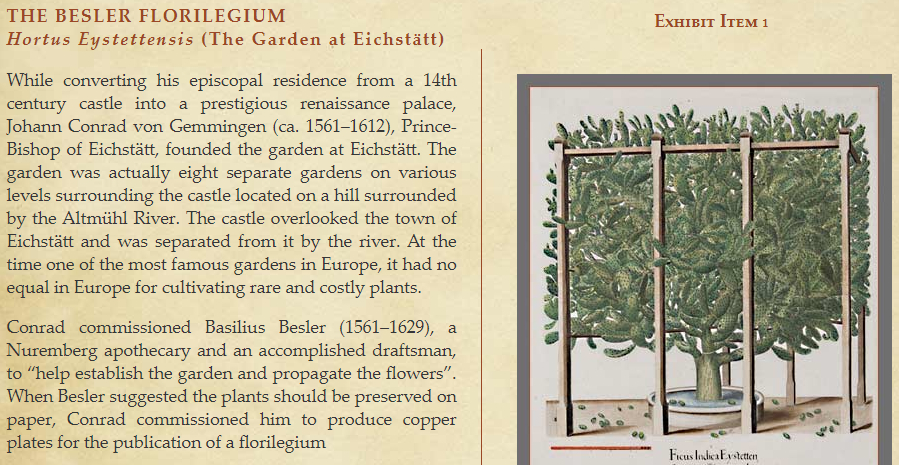
Time-Lapse: Beautiful Cacti Bloom Before Your Eyes
Day 2 – Get Building
Choosing the Right Succulent and Providing the Right Care
5 Common Mistakes in Cactus Care!
Cold Hardy and Soft Succulents
5 Extreme Heat Tolerant Succulents
Types of Succulents to Grow Indoors
Basic Tips
Succulent Garden Tools
How and When to Water Succulents
How and When to Fertilize Succulents
[expand title=”MORE VIDEOS” rel=”fiction”]
5 Indoor Succulent Care Tips
Diagnosing Problems
Why are the bottom leaves dying?
[/expand]
Design Time
Succulent Design Tips
Cold Hardy Succulent Arrangement
Vertical Succulent Arrangement
[expand title=”MORE VIDEOS” rel=”fiction”]
Large vs Small Succulents
Designing a large arrangement
Make a Succulent Wreath
[/expand]
Activity Time
Repurpose Tea Tins!
Popsicle Stick Mini Pallet
Succulent Topped Pumpkin
Teacup Fairy Garden
How to Make a Mini Fairy Garden
Day 3 – Artistic Expression
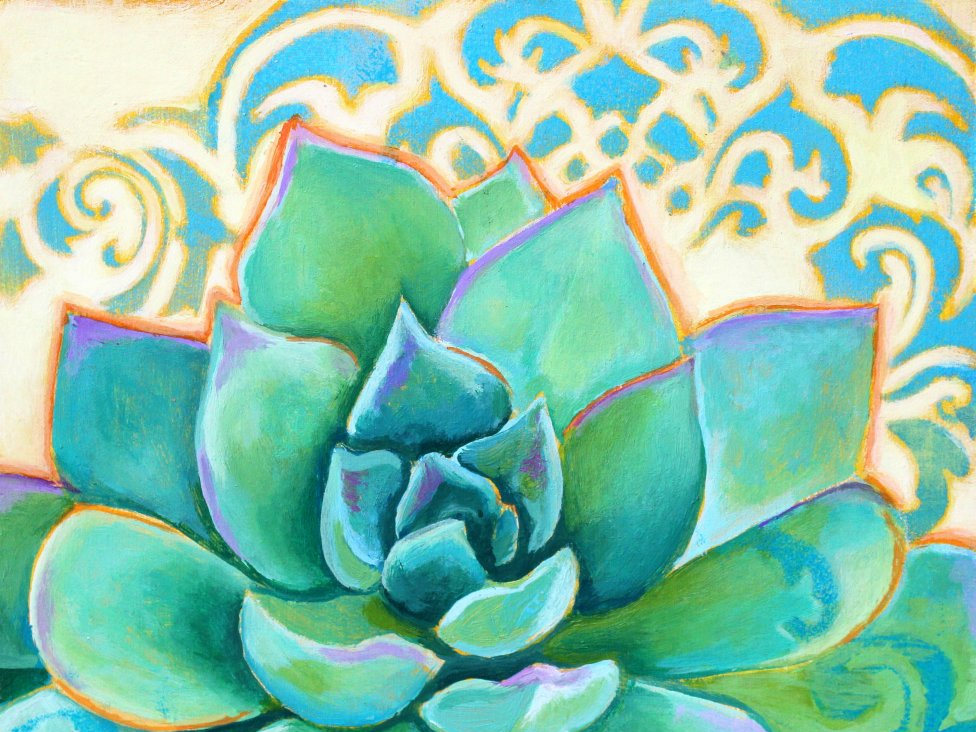
Download this week’s coloring sheets showcasing Succulents!
Get To Know The Artists
Regina Lord
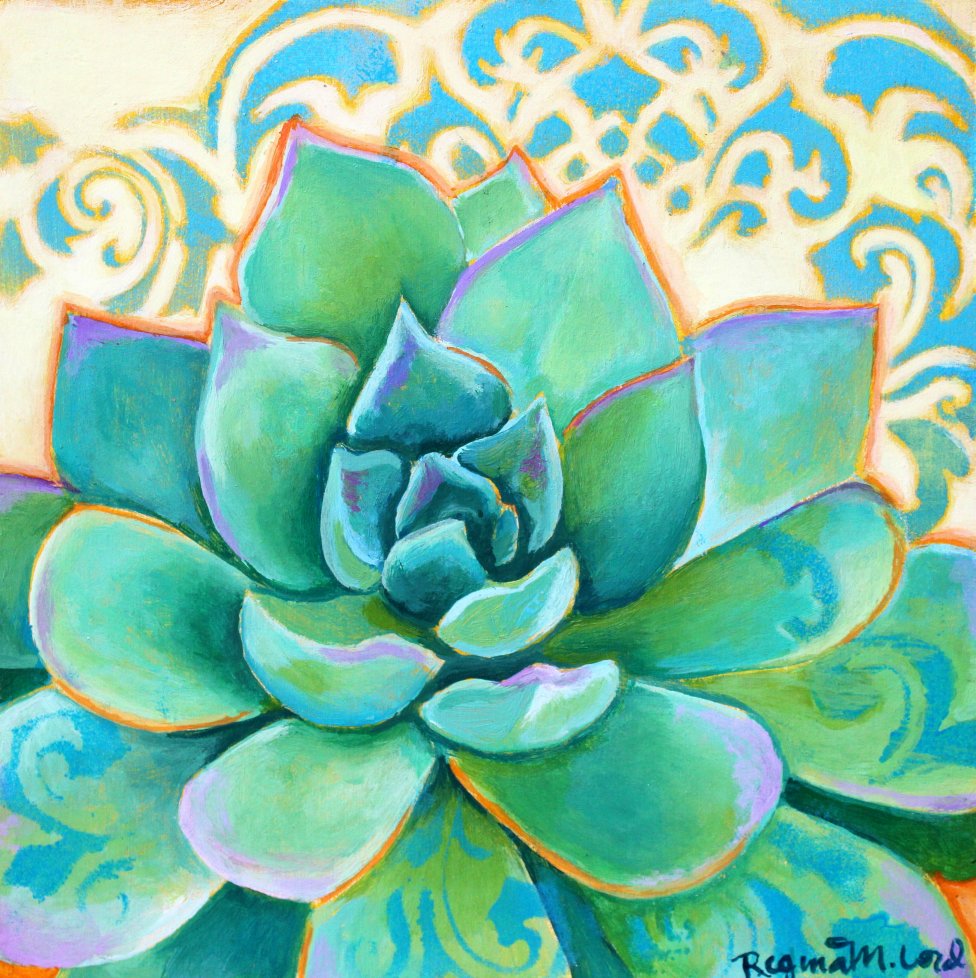
Succulent
Regina Lord believes, through art and creative process, your outlook can change and become more positive, more open. As an artist, she starts by first looking for beauty and inspiration.
More
It is in the southwestern mountains, the desert, in nature and wildlife, in the streets, and in the people too. Her style is the unraveling of a woven mixture of her Hispanic heritage, deep-rooted love for folk art and an enchantment with magical whimsicality. She began putting ideas down on paper, making doodles and sketches, finally pulling out various paints, papers and any other media that feels right. With a paintbrush and the boldest colors, Regina pulls ideas together in the best way that makes her heart sing. Always bright, always colorful, always filled with joy.
Regina Lord was born and raised in Northern Arizona and has lived in Arizona for most of her life. She was very interested in art at a young age and was encouraged to be creative by her loving grandparents. Regina studied art throughout her school years along with studying to become a registered nurse. She received her BSN from Northern Arizona University in 1999 and worked as a nurse for almost 15 years in various hospital settings. Eventually, the call to become an artist became so strong that she left her nursing career behind to pursue her creative dreams. She now spends her time making art and playing with paints and other interesting mediums.
Regina currently lives in Southern Arizona with the love of her life and her two beautiful boys. She is strongly influenced by the warm weather, bright sun and the Mexican colors, style and architecture that are predominant in Tucson, Arizona where she lives. She is very passionate about doing what she loves and incorporates art into her daily living whether through painting, drawing, photography, art journaling or blogging about her creative passions.
To learn more about Regina and her work, visit http://www.creativekismet.com/
Erinn Kennedy
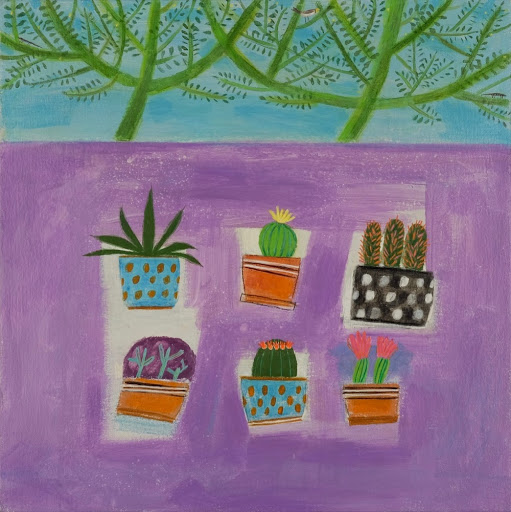
Plant Sale
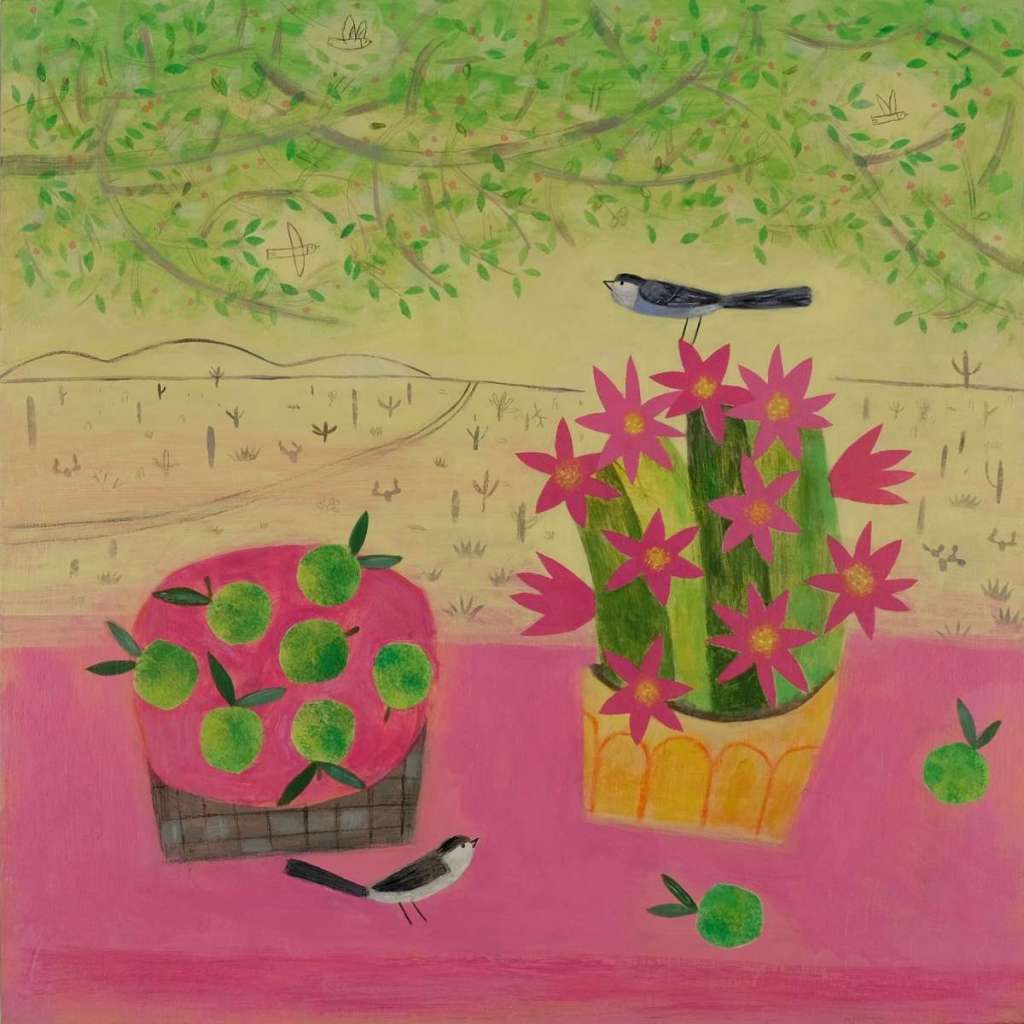
Still Life with Hedgehog
“I paint the objects and places that I love and are a part my everyday life. I find inspiration in the Sonoran Desert landscape in and around Tucson, Arizona where I live. I am very interested in its natural beauty, historic manmade structures, and stories left behind. I am equally interested in the atmosphere that surrounds these places and the moods they evoke.
More
When I see a still life arrangement or an outdoor scene that captures my attention I will make several sketches of it from observation, emphasizing spatial relationships, passages and colors that I find interesting or unexpected. When starting a painting I put these sketches away and work from memory and attempt to capture the beauty and essence of these engaging places and things.”
To learn more about Erinn Kennedy and her work, go to http://www.erinnkennedy.com/index.html
Maddie Tsurusaki
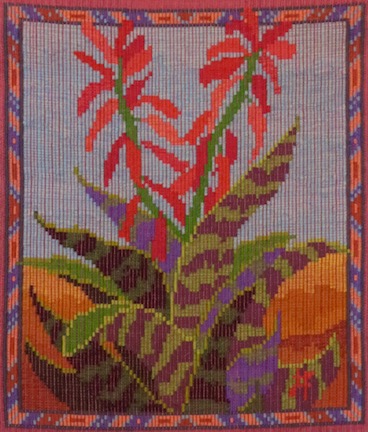
Blooming Aloe
“Small succulents thrive in the desert. They surround us in gardens, parks and patio pots. In fact, they are easily overlooked until they bloom. Then, the flowers stretch to the sky in glorious vibrant colors. This one, with its red blossoms and zebra-striped leaves, made me stop for a photo that eventually became a tapestry. It was woven on a four-harness floor loom using a Scandinavian technique called Dukagong.”
More
Maddie Tsurusaki has been weaving for forty years between children, degrees, and traveling. She continues to learn new techniques by attending workshops and studying books.
Tom Baumgartner
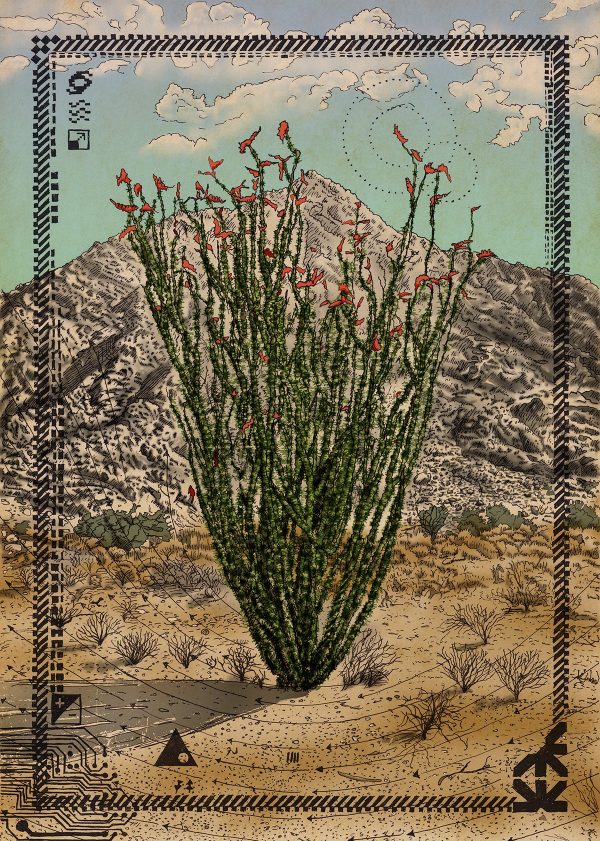
Ocotillix Rosario
“In the Sonoran Desert, some areas get more rain than others. Around Tucson, the yearly rainfall is 12 inches, but in the El Pinacate y Gran Desierto de Altar it’s closer to 3 inches, if any at all. Rain is usually sourced by a Pacific hurricane or tropical storm coming inland to die. Hardy, adaptive plants, like the ocotillo, growing in an area with less rain may look young but can actually be very old. How old? Sometimes more than 100. In between rains, an ocotillo dials its metabolism down to a crawl and appears to be a bundle of dead, spiny sticks. When it rains, it springs into action by sprouting leaves and bright red, torch-like blooms. Pollinators, like carpenter bee and hummingbird, are attracted to the blooms.
More
This ocotillo was found in the Gran Desierto de Altar at the foot of the Sierra del Rosario Mountains. I was taken by the height of the ocotillos in this area compared to most of the shorter, ground-hugging plants and the sound of wind through their spiny branches.”
To learn more about Tom Baumgartner go to http://patterntology.com/
Day 4 – Artistic Interpretation
A conversation with artist Rick DeMont and James Schaub, Tohono Chul Curator of Exhibitions
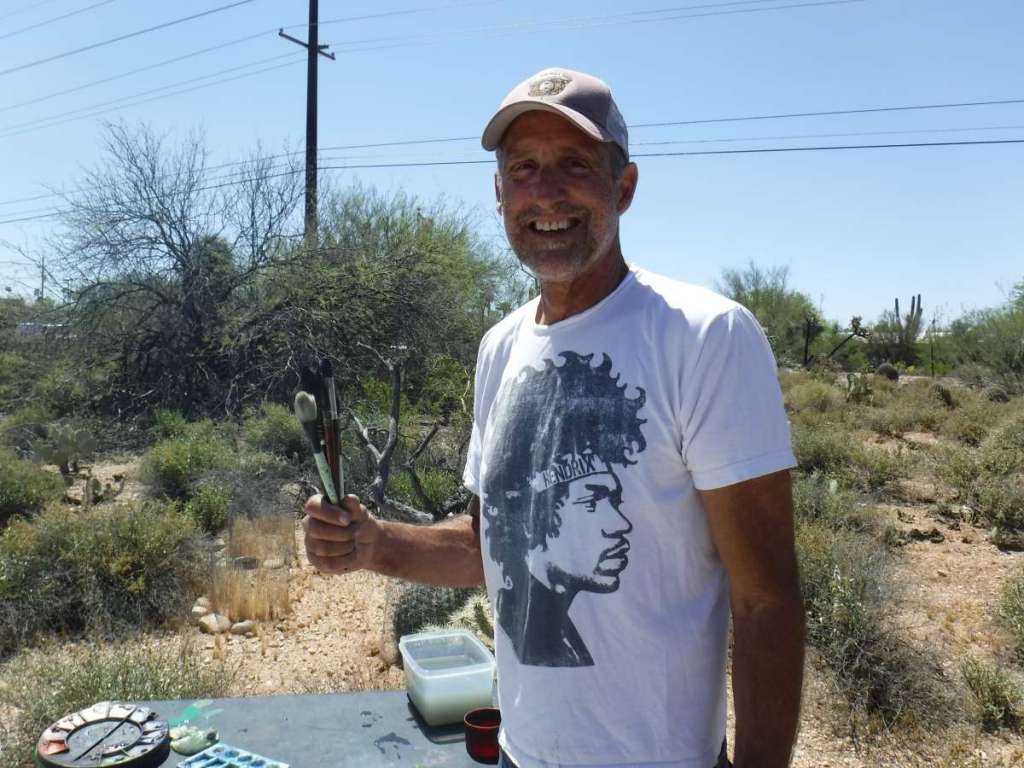
The artist studio is place I revere. It is an intimate space to think and create. It can be the smallest of rooms or the largest of warehouses. It can be spare or cluttered. It can be raw or refined. Either or, or somewhere in between, the studio is always about the artist who works in it. Is a telling place. It reveals an artist’s affinities and potential. When it has a lived-in feel and is marked by experience, the studio permeates the art that is produced in it. What you see in a corner, on a table, on a shelf, possesses an intrigue that burns into your memory as strongly as the work you have gone to see – sometimes stronger. You will see tools, ideas, and materials. The way they are laid out, lay bare the artist’s intent and process. The extra dose of insight and information the studio offers, forms a connection to the artist – unobtainable any other way. Seeing artwork in the environment in which it is created is an experience far greater than seeing the same piece on a gallery wall or pedestal. Being invited in, is an honor.
[expand title=”READ MORE” rel=”fiction”]
What if the studio is not a fixed place? What if it is anywhere the artist wants it to be?
What if you are invited to see artwork being created and you are told to go into the desert?
You go.
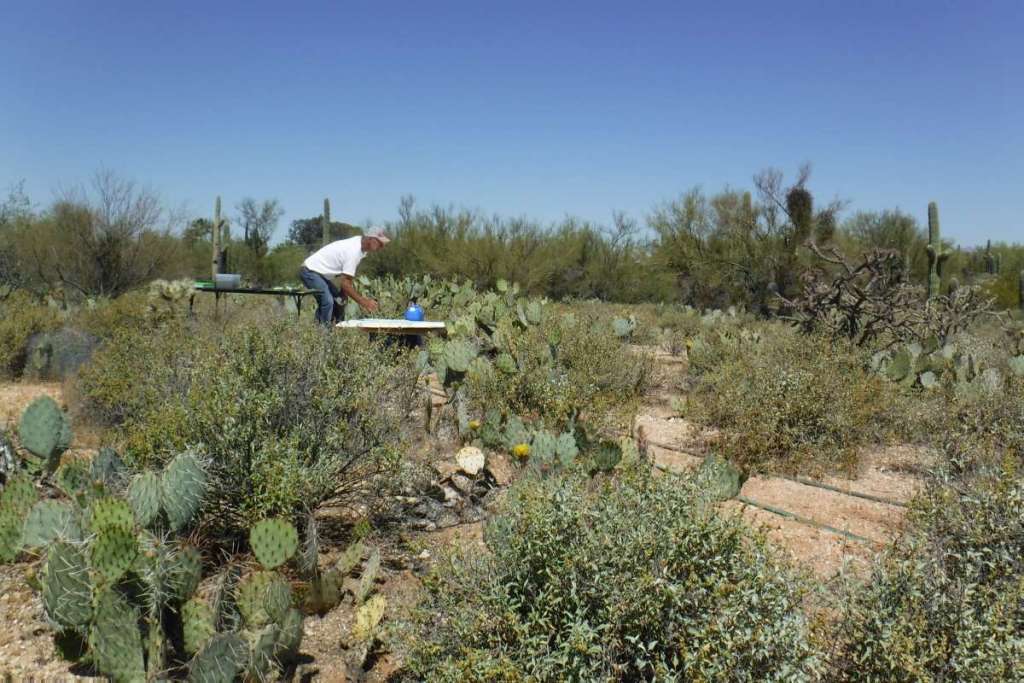
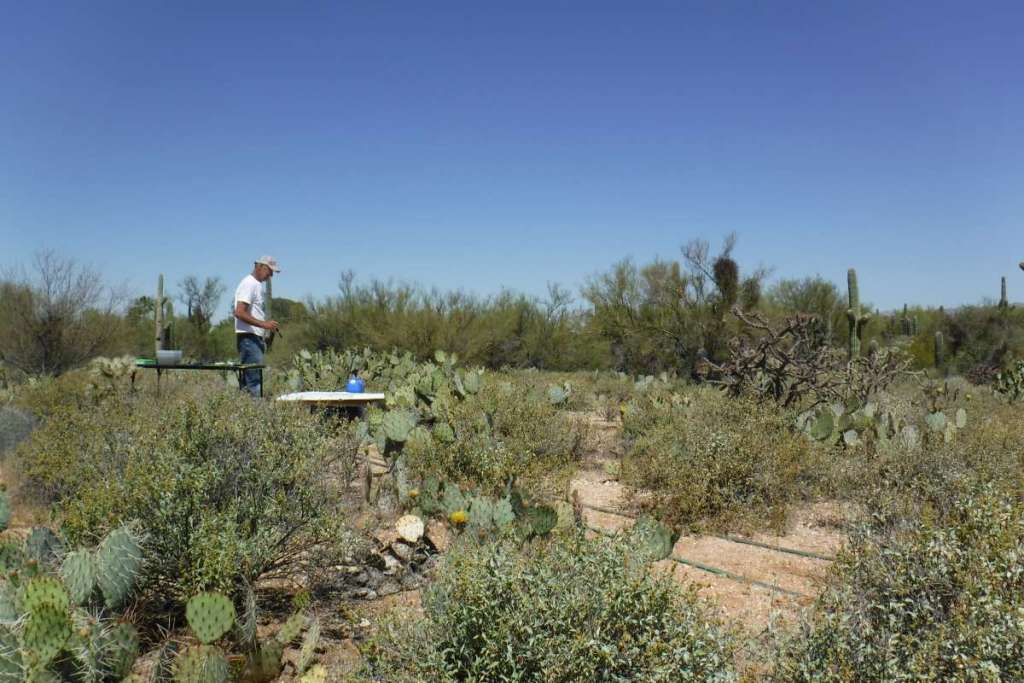
The Tohono Chul exhibition Call and Response invites several artists each year to explore Tohono Chul’s Permanent Collection. They are asked to select an object that calls to them and then, respond to it through the contemporary filter of personal experience. The traditional object and the contemporary object are exhibited side by side. With the Exhibit House set in the center of the Tohono Chul’s thoughtfully planned and finely crafted gardens; I feel that with each installment of Call and Response, Tohono Chul’s natural beauty should be honored with a temporary place in the Permanent Collection. This year I asked Tucson based artist Rick DeMont to think about and contribute artwork that speaks to the ideas, functions, and importance of gardens in our daily life.
DeMont is painter. He works with oil paint on canvas and watercolor on paper. He works with the landscape. He works in the landscape.
After I invited Rick to be part of Call and Response V, Rick invited me to visit him while he worked in his studio. I accepted, One morning a few weeks ago he called and told me to go out to Tohono Chul’s Saguaro Loop Trail.
It was already hot, about 100 degree and 10:30 a.m., the snakes were still moving around. He had been out there, working, since 7:00 a.m.
A good distance from the trail, even farther from his truck, there was Rick, mesmerized and focused, in the thick of it – surrounded by cacti, at home in is studio: an old folding table with four big palettes loaded with moist and crusty globs of watercolor squeezed from the tube (two for earth, one for plants, one for skies), a large mounting board to work on, one 40 in. x 60 in. sheet of hot pressed T.H. Saunders watercolor paper, an assortment of huge vintage sable and squirrel hair brushes that resembled mops, and a beat-up blue six-gallon Igloo jug (about half filled now with warming water) to drink from and paint with. The temperature was now over 100˚, the sun was almost directly overhead – it was blinding. His eyes couldn’t take it anymore. DeMont was smiling – he couldn’t have been happier.
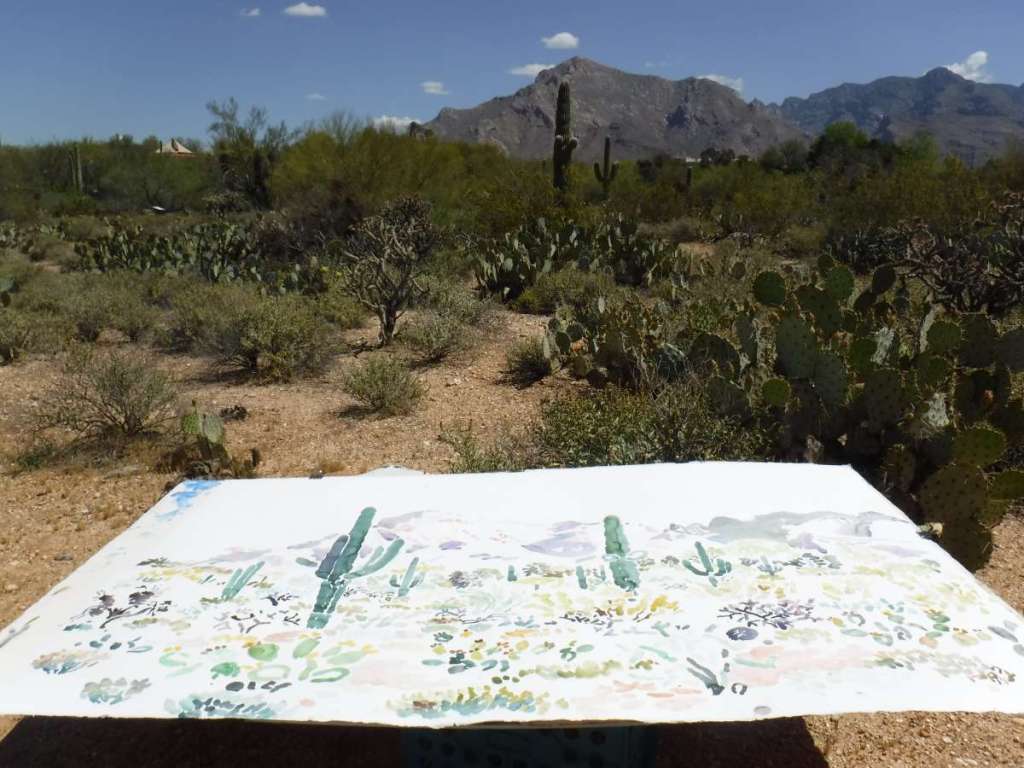
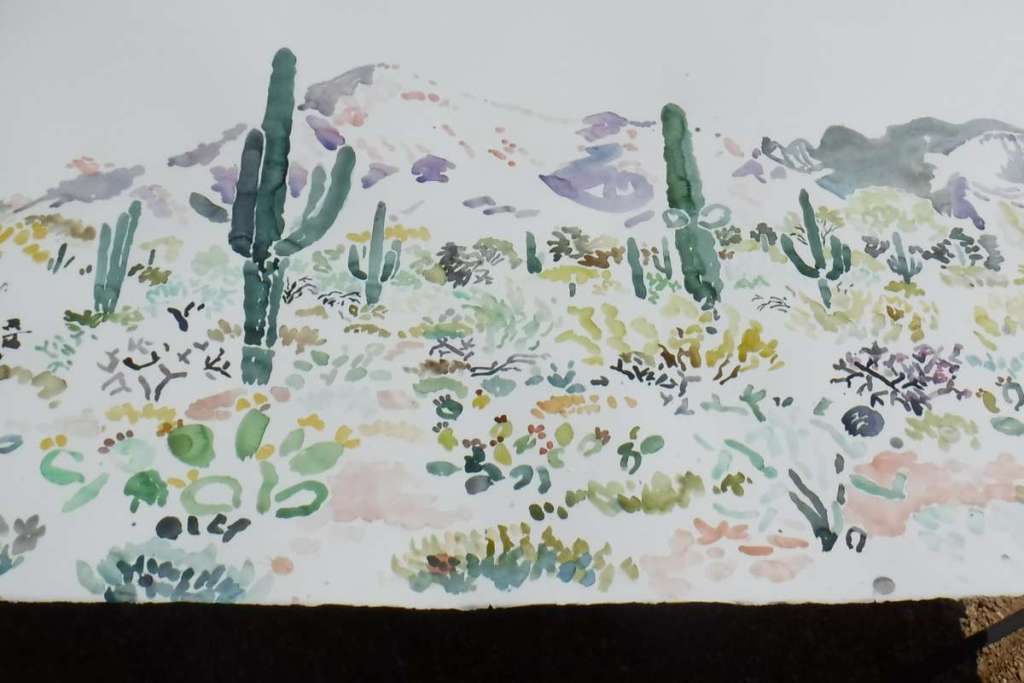
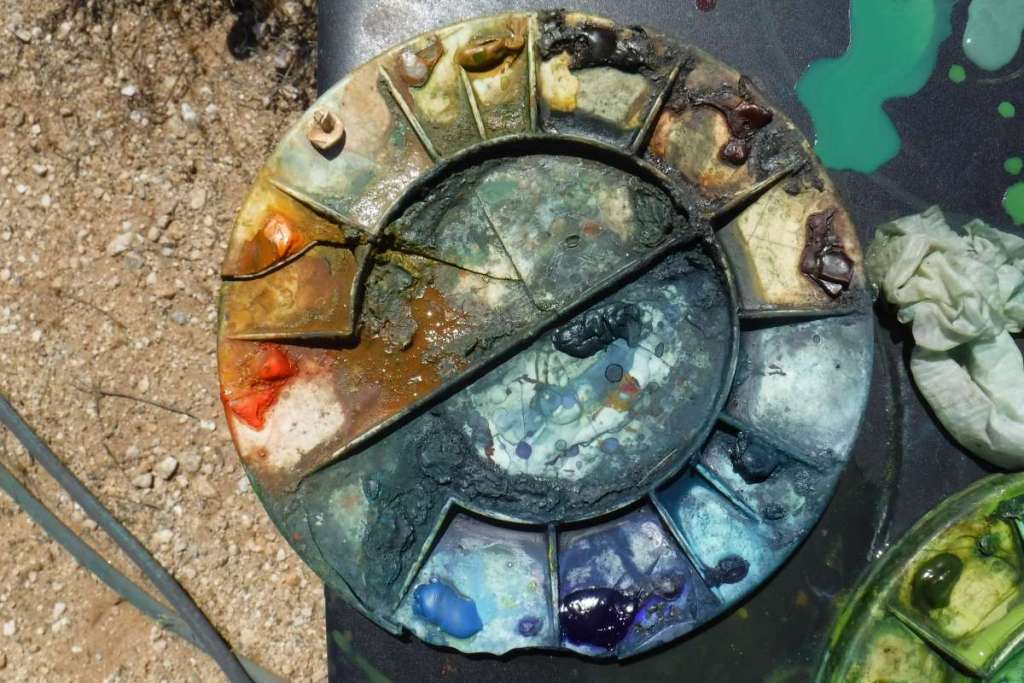
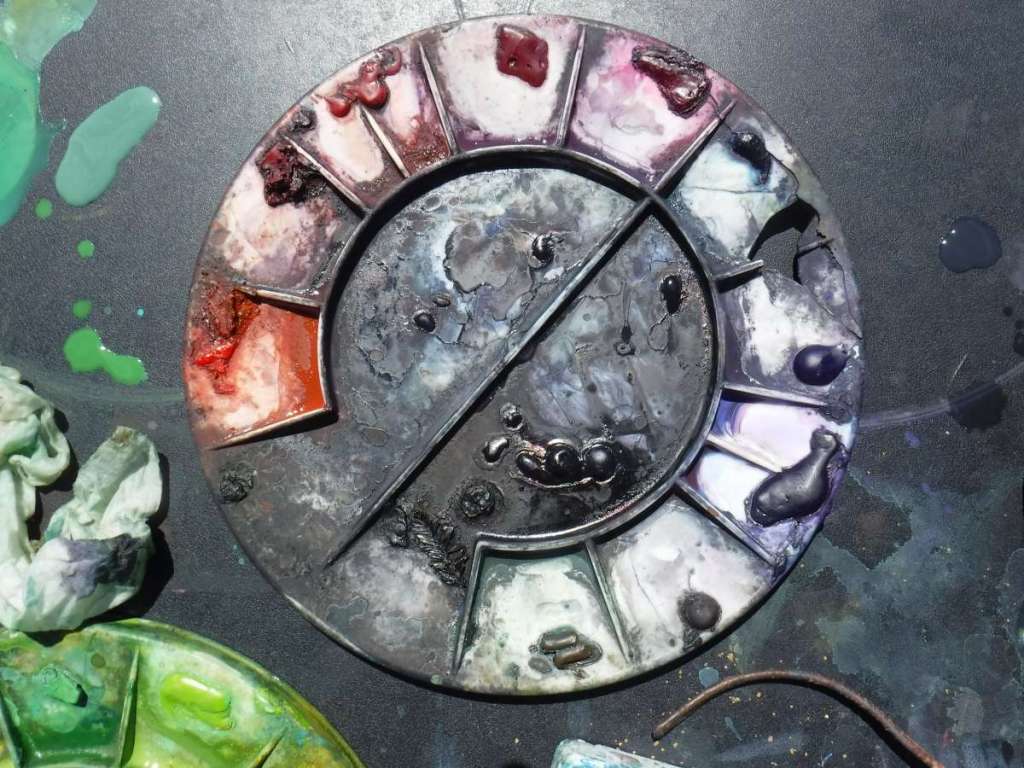
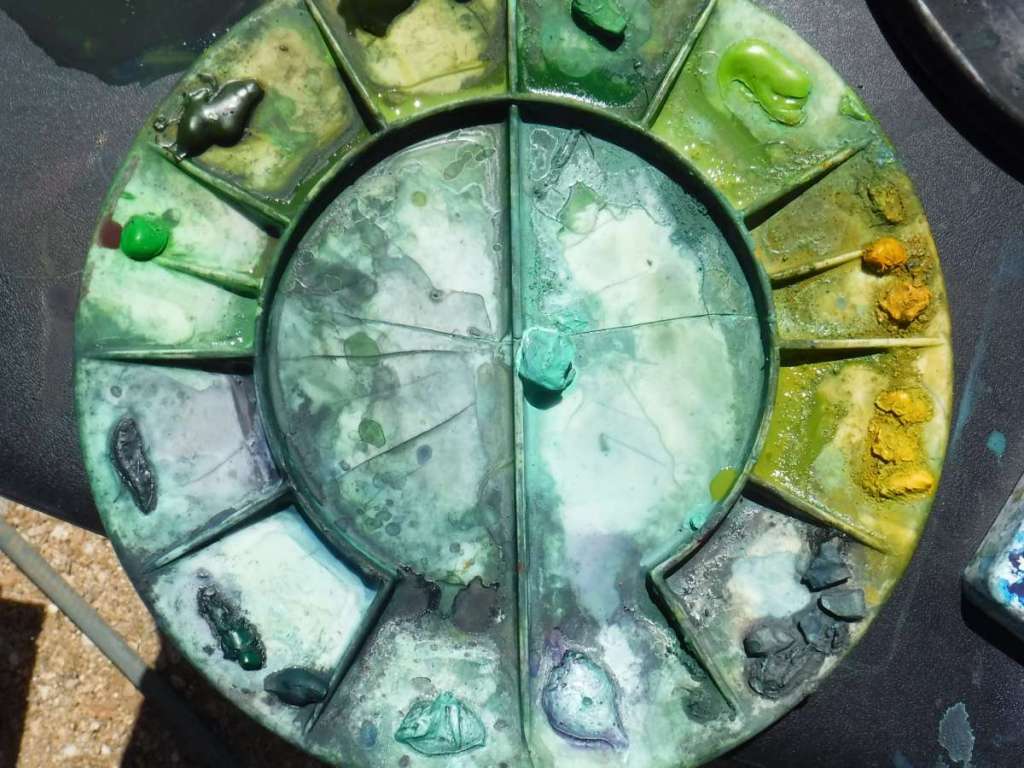
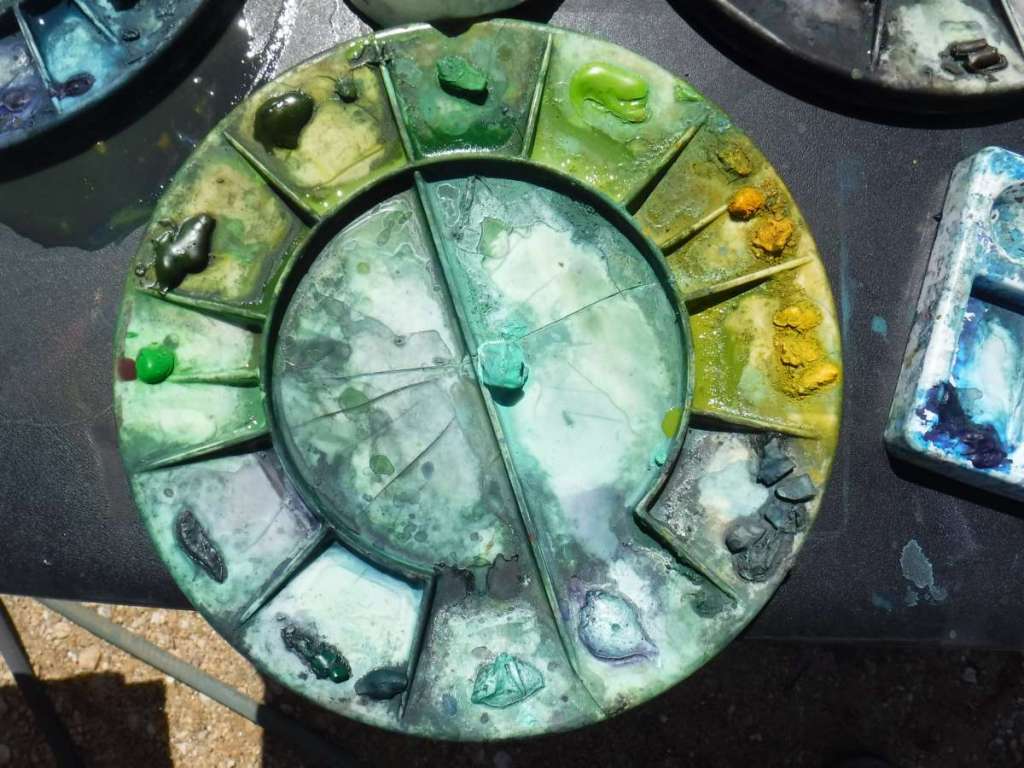
When I saw what he was working on, I too, couldn’t have been happier.
Some days before, we walked the 49 acres together – and settled in on several sight lines that offered his imagination something vast and timeless. Rick told me, “I know what I want to paint when I see it. In some works I trek away from the well-worn path, in others I am simply several feet off the road; yet always, I seek a peaceful and unspoiled landscape.”
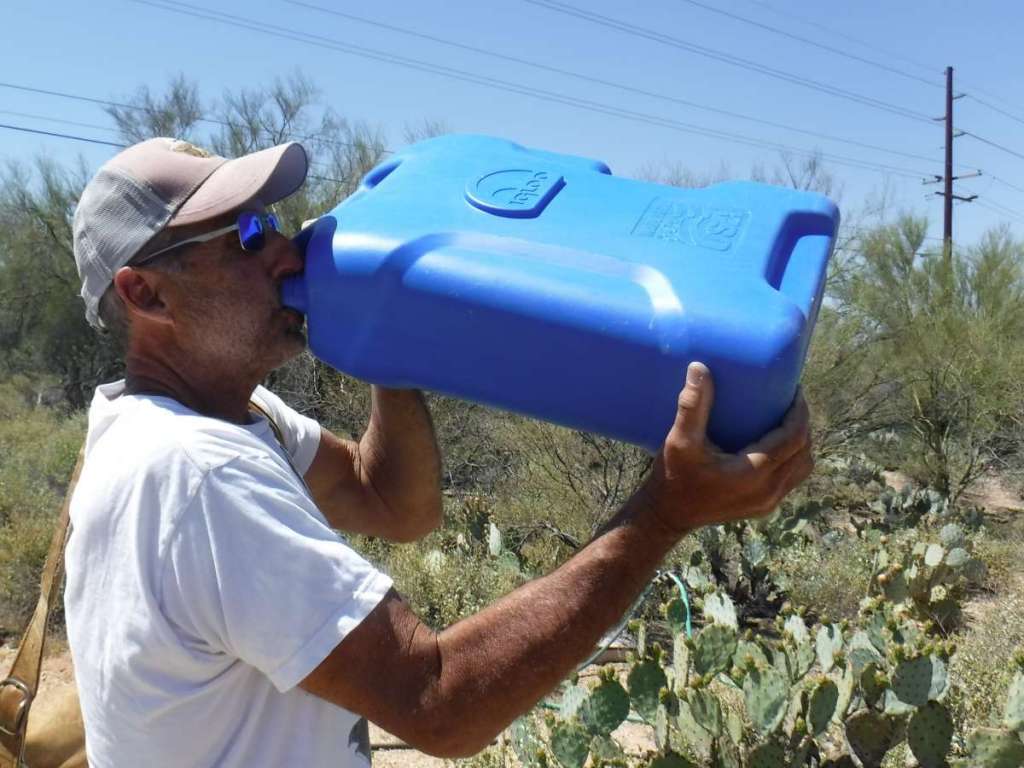
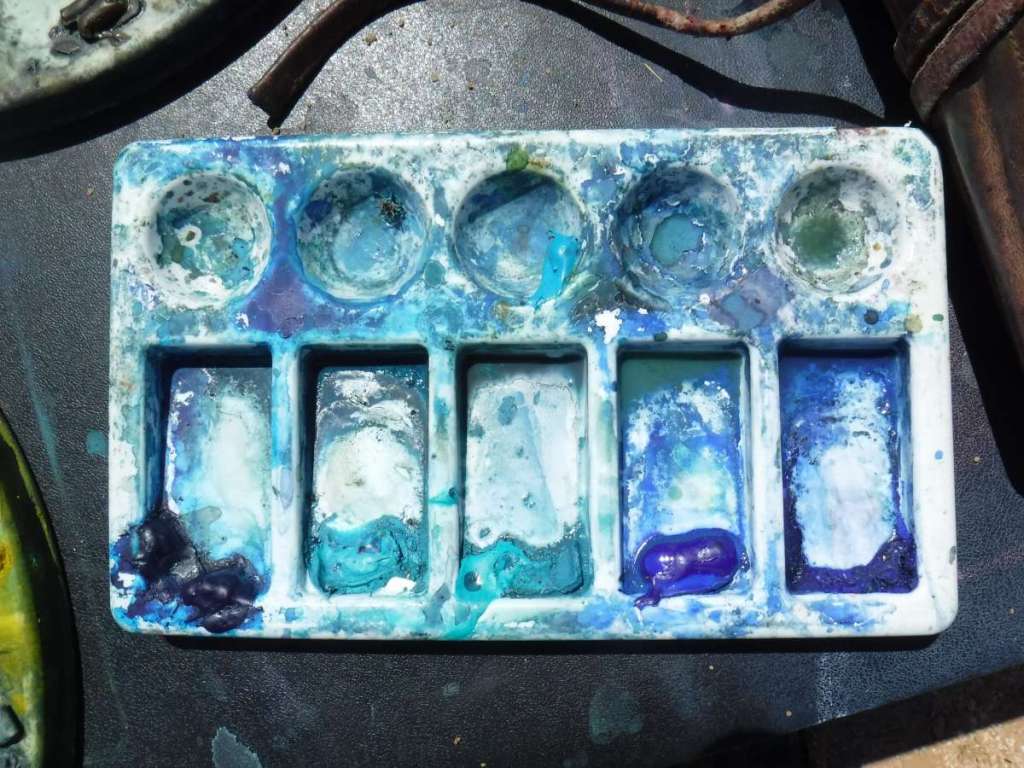
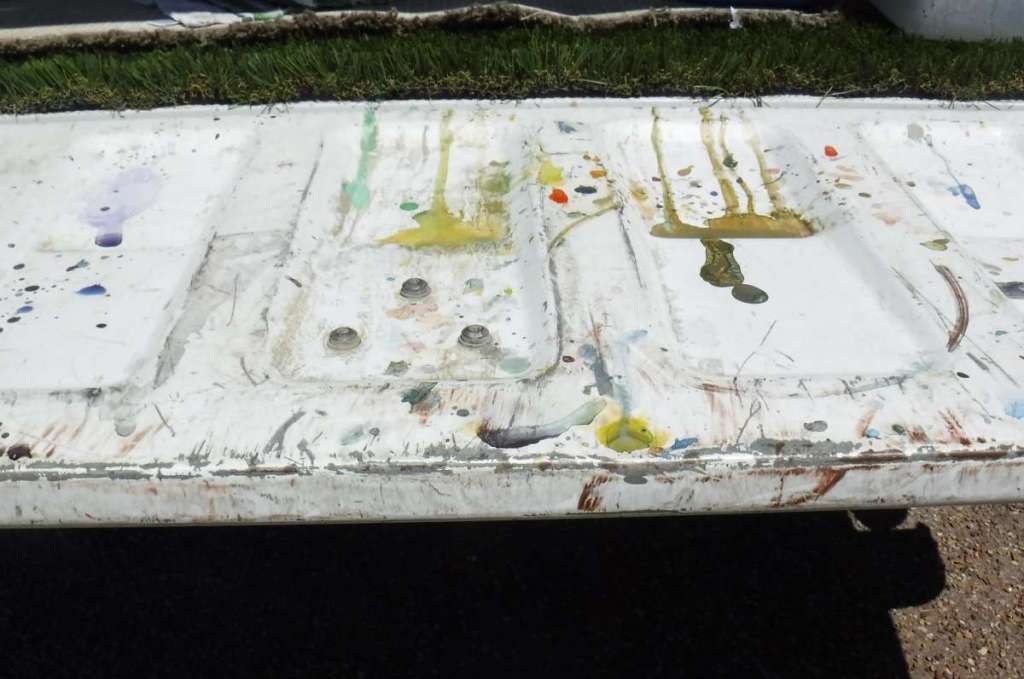
On this day, Rick had set his studio looking northeast toward the Santa Catalina Mountains, he imagined a Tucson before the pandemic, before the fire, before people.
Beginning when the sun and temperature helped him along. The morning saw him working deliberately – en plein air – plotting the terrain before him to the paper in front of him – not drawing with the brush but laying down stokes of color that are just as much about the act of painting as they are notional reminders of where the scene is heading. DeMont says, “What I am thinking about, or not thinking about when responding to the magic before me, is to create an illusion with jeweled strokes of color. My hope is that each stroke has an aesthetic value on its own and when put together, adds up to more than the sum of its parts.” The elements of the landscape are all present, referenced across the paper’s expanse is saguaro, cholla, prickly pear, palo verde, earth, rock, mountain, cloud, and sky; with the white of the paper defining and heightening each element to the same degree as the paint does. Slowly the marks, shapes, and arcs, all different in weight and measure, coalesced into what Rick needed to continue. His energy never waned, and by noon, he had what he wanted – a map to the finished work he would complete in his home studio.
Looking at DeMont’s finished works and his works in progress you realize his mastery of color, scale, and space. Each composition’s strength is generated by active and allover weavings of saturated hues and joined shapes that conjure shards of intricately pattered mosaic up close and distant desert vistas from several feet away. DeMont shifts the broad sweeping expanse of the desert’s earth and sky away from the local color employed by most artists and, tinging the atmosphere with something uniquely his, he moves his whole vision into the realm of the sublime. Each large sheet of paper, drenched in a tapestry of deep, rich color, with its myriad marks, dots, and strokes is simultaneously a reflection of the pure landscape as DeMont had witnessed and an abstract entrance toward the wonders of the natural world.
Helping Rick move his portable studio back to his truck – I couldn’t help but wonder where his work would take him next. The brushes, the paper, the jug, the palettes – would they get bigger, and more powerful – grander and more sublime?
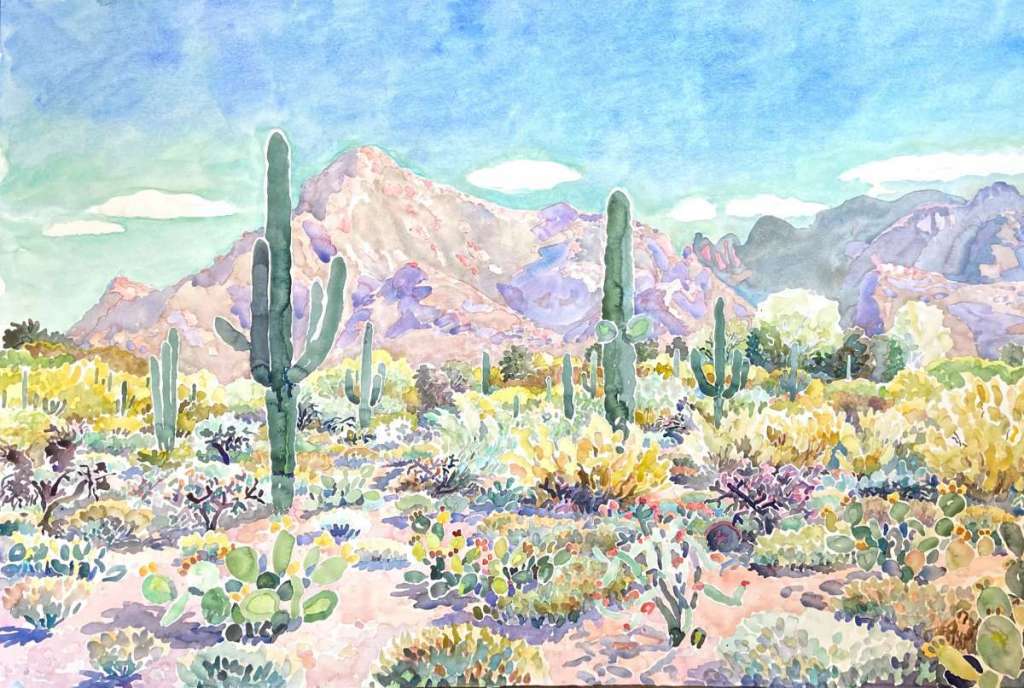
About The Artist
Rick DeMont loves all cacti – but, when pressed for his favorite, he first thought of the saguaro and its place as “The Giant of the Desert,” but reversed course and upon reflection said he was quite partial to cholla, of all kinds – deeply drawn to their colors, lines, shapes, patterns, buds, spines, and flowers and of most intrigue to him as a painter – their “ability to glow and emit light.”
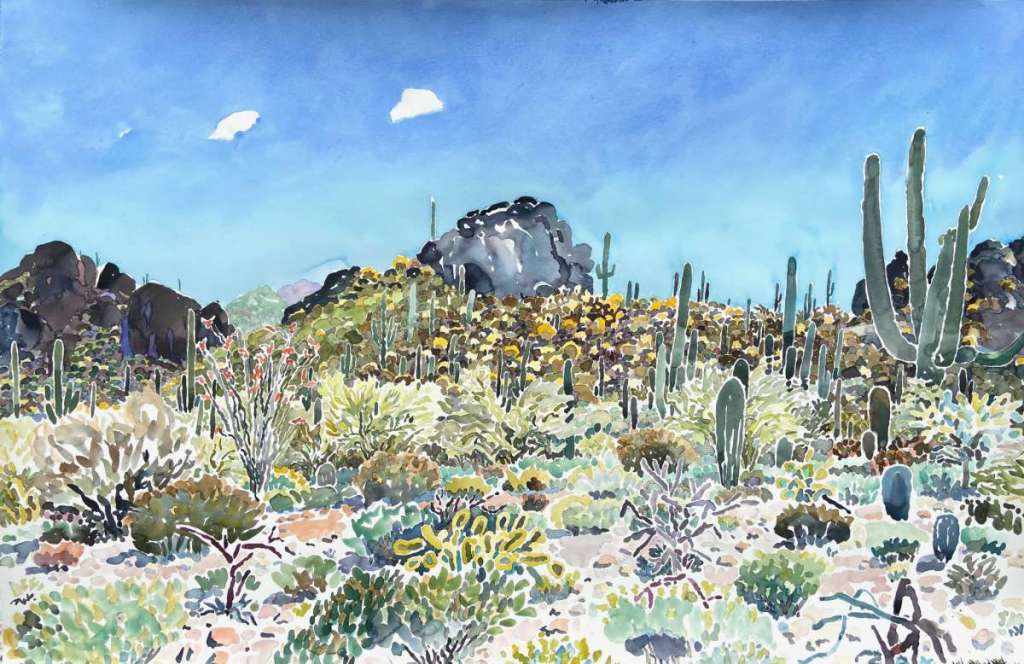
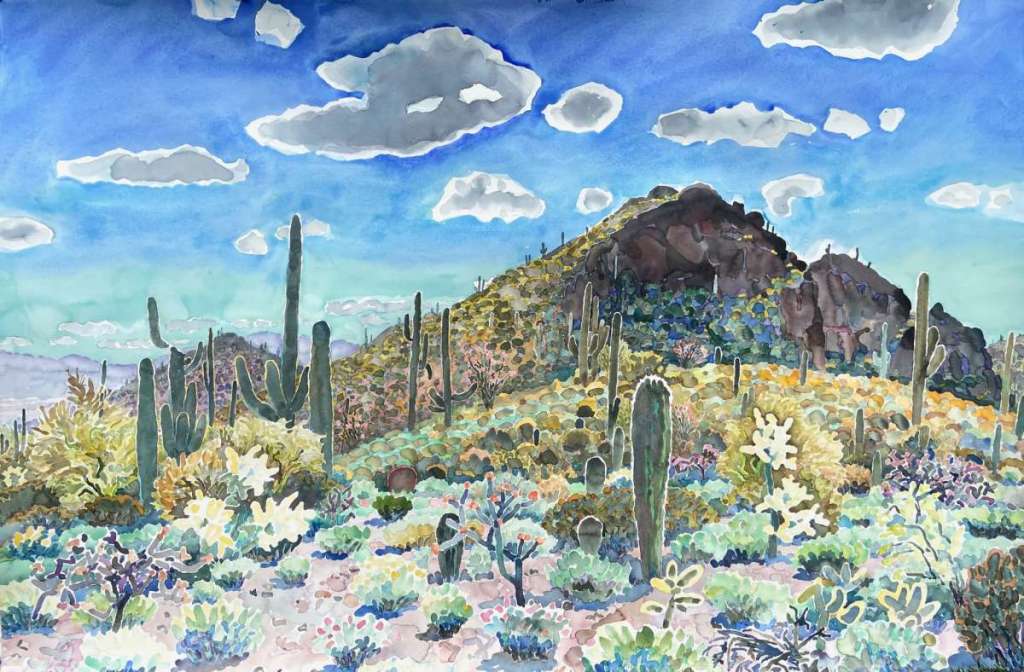
DeMont has been working on large 40in. x 60 in. watercolor paintings out in the Sonoran Desert since the Covid-19 shutdown started in mid-March 2020. The three paintings that accompany this BLOGpost were painted en plein air in the Tucson Mountains (Tucson Mountains no. 1 and no.2 ) and at Tohono Chul (The Santa Catalinas from the Saguaro Loop Trail, Tohono Chul).
Rick DeMont was born in San Francisco in 1956. He was exposed to the art world at an early age by his Grandmother, a painter and photographer. DeMont, a former Olympic and World Champion swimmer, attended the University of Arizona on a swimming scholarship where he received a B.F.A in 1979. In 2017, after 30 years of coaching, DeMont retired as the Head Coach of The University of Arizona Swimming and Diving Teams. Rick operates a studio at his home in Tucson and anywhere he decides to paint.
Rick DeMont’s paintings have been exhibited in solo and group exhibitions throughout the United States. His works are in public, private and corporate collections, including: The University of Arizona; Beaver Creek Lodge in Vail, CO; Tumbling River Ranch in Grant, CO; Bourne Partners, Tucson, AZ and the DeConcini Building in Tucson, AZ. His work was featured in the Tohono Chul exhibition SONORAN STORIES (2018) and is currently installed as part of exhibition ON THE DESERT: the Discovery and Invention of Color. Demont new painting, painted en plein air, off of Tohono Chul’s Saguaro Loop Trail will be featured in Call and Response V during the Tohono Chul 2020-21 exhibition calendar.
Rick DeMont is an honorary member of the Southern Arizona Watercolor Guild.
To learn more about Rick DeMont go to: http://rickdemontart.com/
[/expand]
Succulent-Inspired Artists
Kazuma Sambe
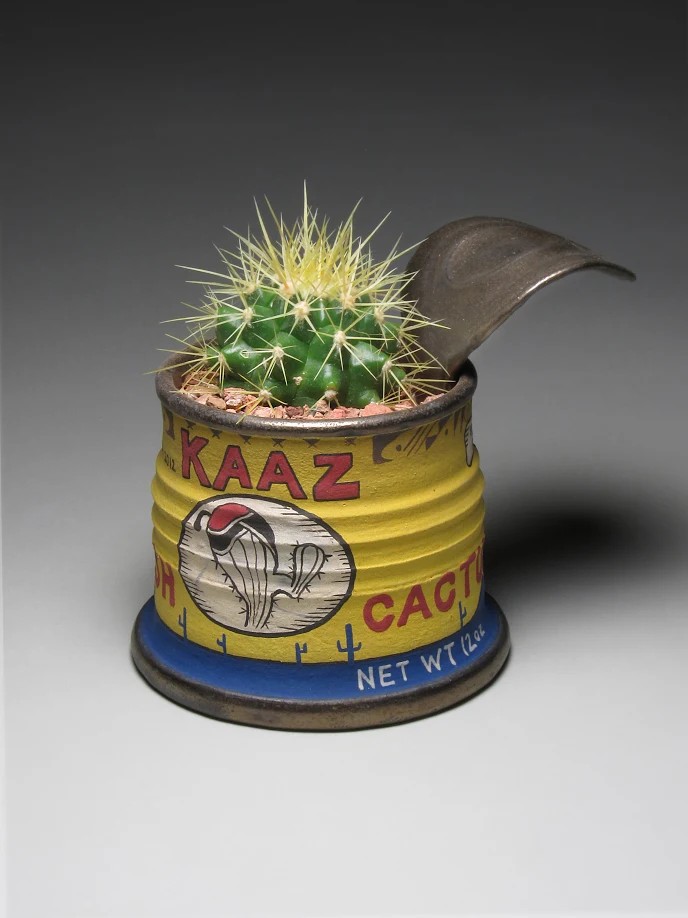
Kaaz’s Fresh Cactus
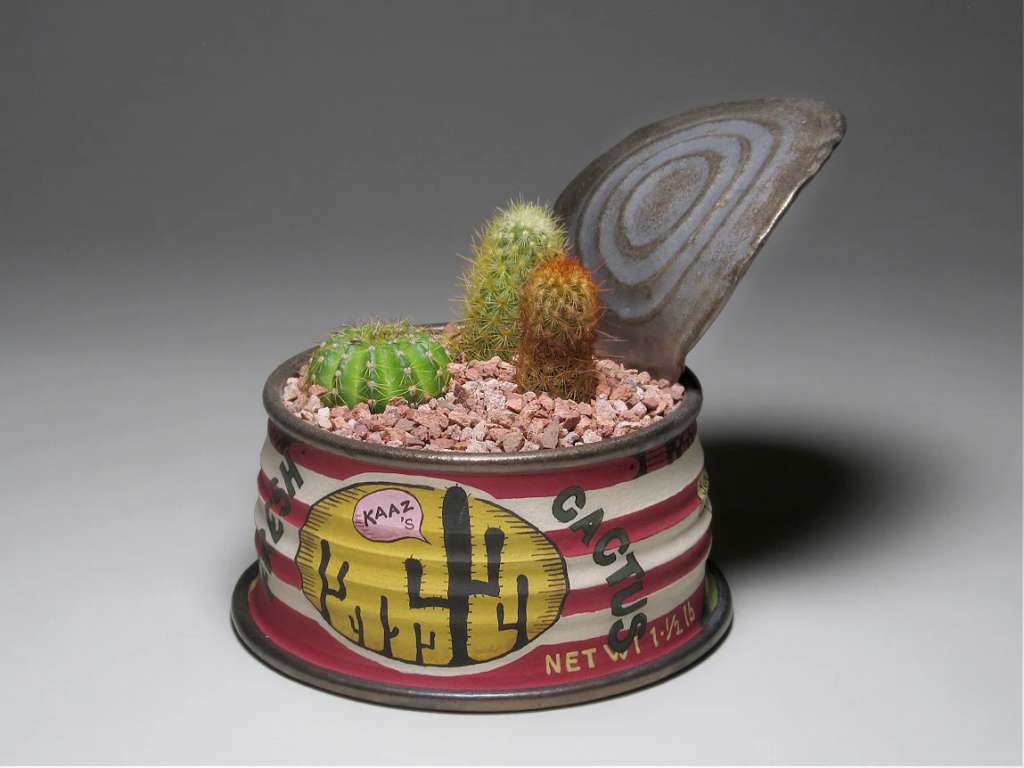
Fresh Cactus 26
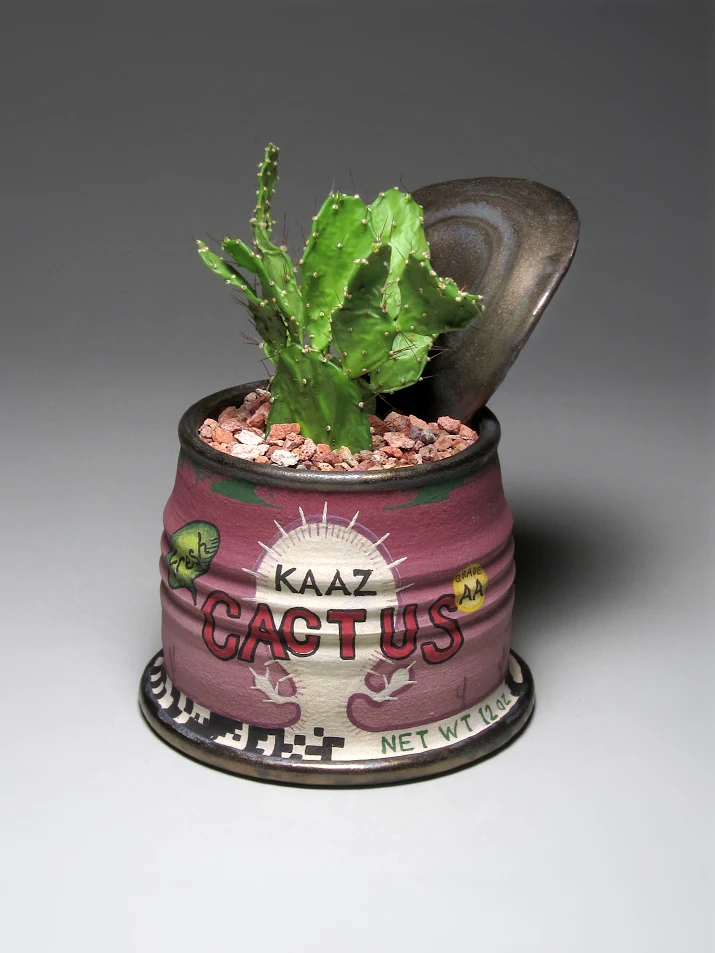
Kaaz’s Fresh Cactus No. 1
Kazuma Sambe was born in New York in 1984 as a child of Japanese family. He moved to Japan with his parents when he was 4 years old and was educated there. He then moved to Tucson for studying bio-chemistry. Encountered contemporary ceramics for the first time in his life, but that was the moment he changed his life to art realm. He obtained BFA in 2011 from University of Arizona and MFA from Arizona State University in 2014. He currently resides in Tucson for his production of ceramics.
More
To learn more about KAZUMA SAMBE go to: https://www.kazumasambeceramics.com/
William Lesch
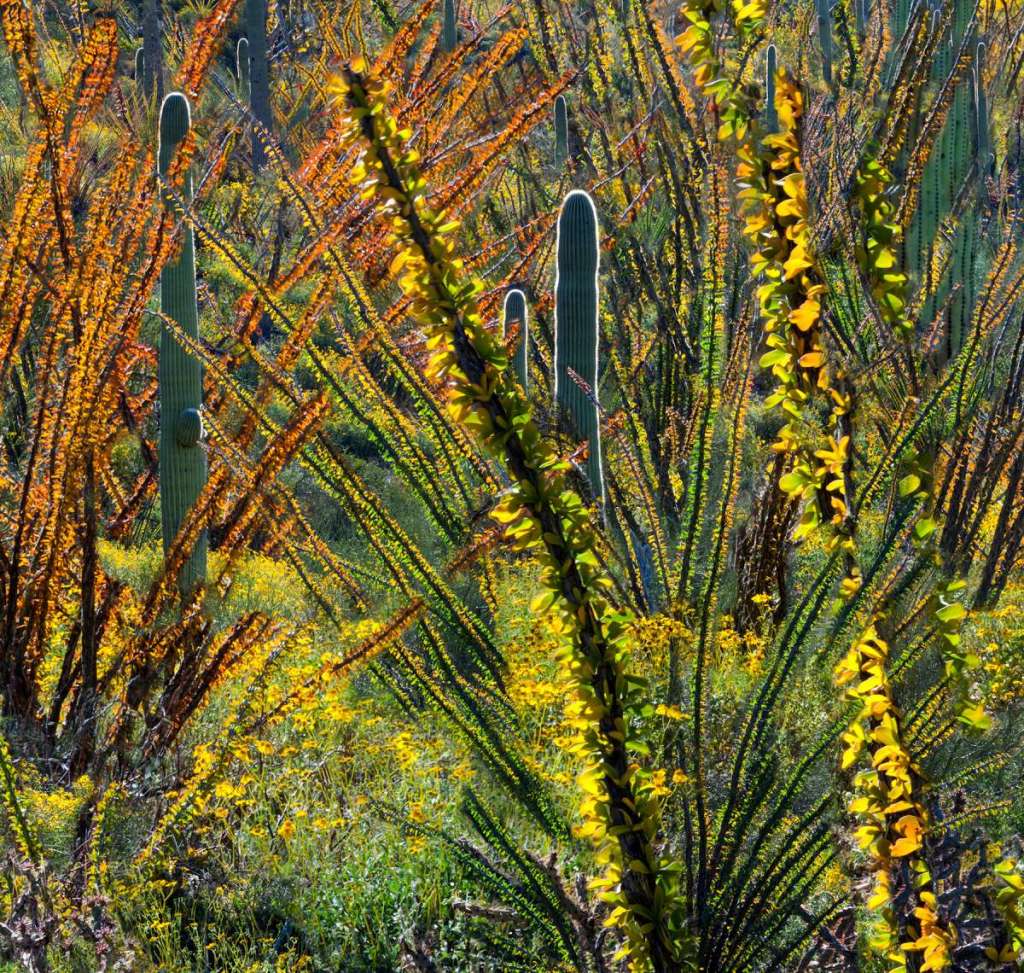
Ocotillo Jungle
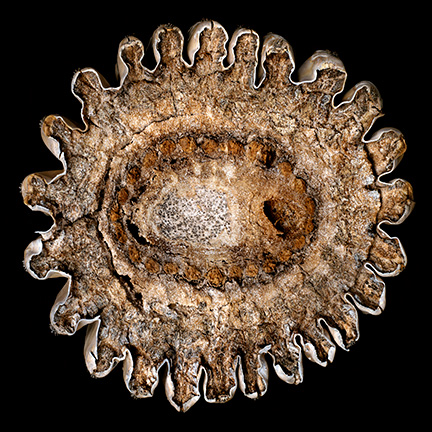
Saguaro . Cross Section no. 4
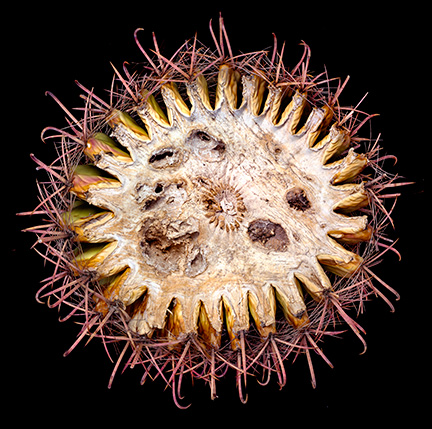
Barrell Cactus . Cross Section no. 1
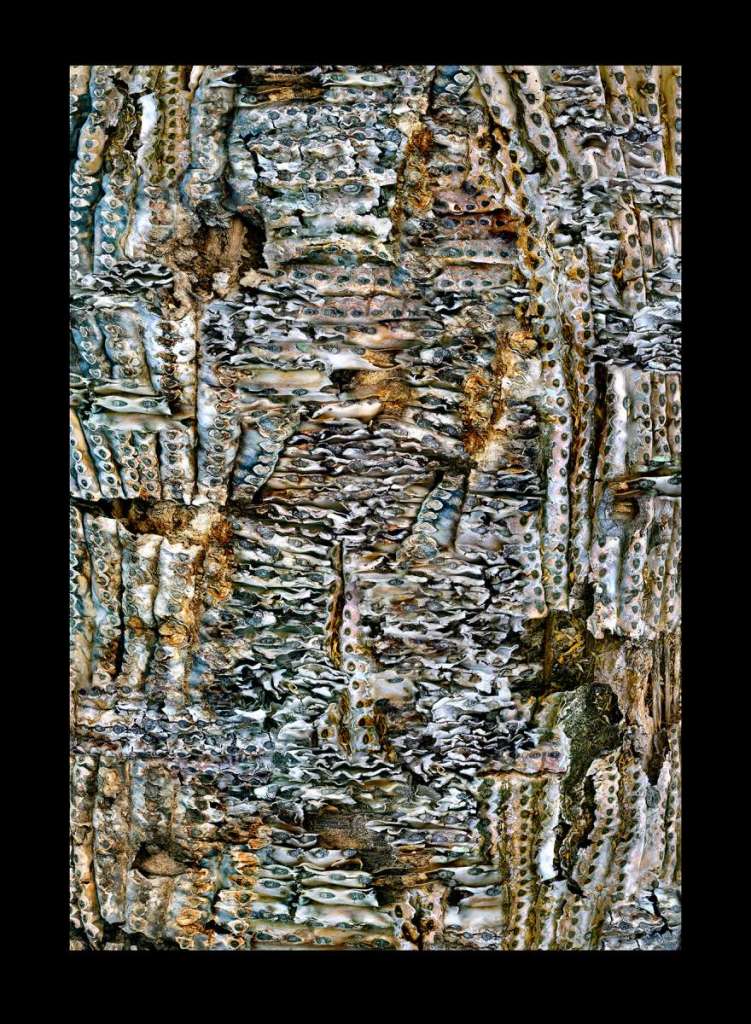
Saguaro Skin Abstract
“Archeologists study the remnants of previous cultures. Pot sherds found along a desert trail can impart a wealth of information about the past. I think of my photographs of cactus skeletons as an archeological study of desert plants. I examine the sherds that cactus leave behind for clues about the desert.
Baked by unrelenting sun, the skin of saguaro, barrel and prickly pear cactus transforms itself in death from tough, green, moisture-loving flesh to the colors and shapes of primitive-fired pottery, abstract patterns like mathematical formulas. As the fallen plants dry and shrink and crack, they become slow-motion artifacts of life and death in the desert.
More
The shots of the cross-sections are of the arms and bodies that fall as the cactus die. Sometimes they break off cleanly, leaving a cross-section that reminds me of MRI scans of the human body. Like tree ring studies or MRI’s of a spine, they leave an abstract pattern that suggests the life history of these giants of the desert.
The poet Wendell Berry writes of the endless cycle of birth, life, death and rebirth. Decay and change are essential to this process, and beautiful in their own way. These photographs are meant to display and celebrate that process, the cycle of life in the desert.”
to learn more about WILLIAM LESCH go to: https://www.williamlesch.com/index
[expand title=”MORE ARTISTS” rel=”fiction”]
Lex Gjurasic
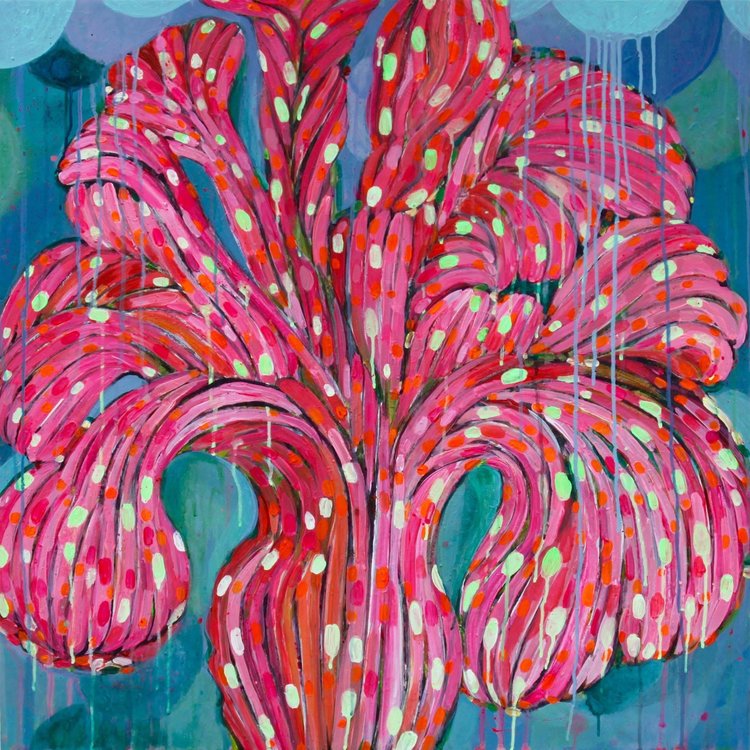
Bubblegum Saguaro
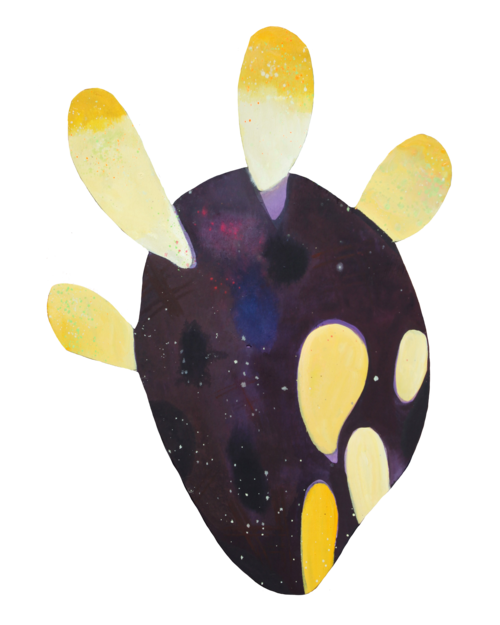
Grape Paddle
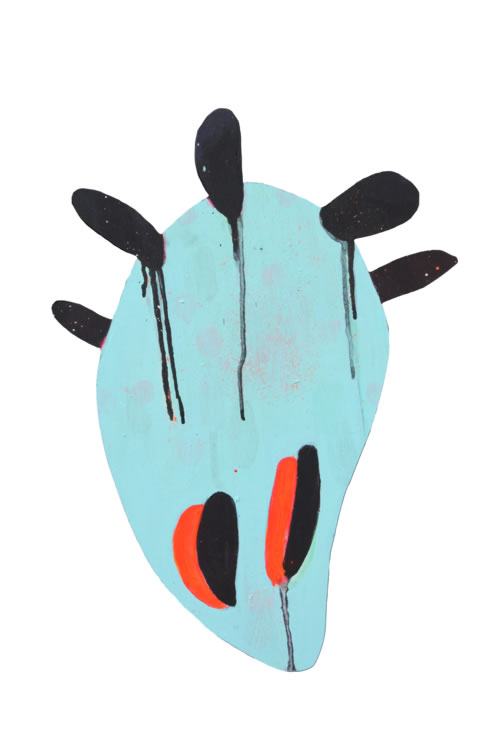
Sea Foam Paddle
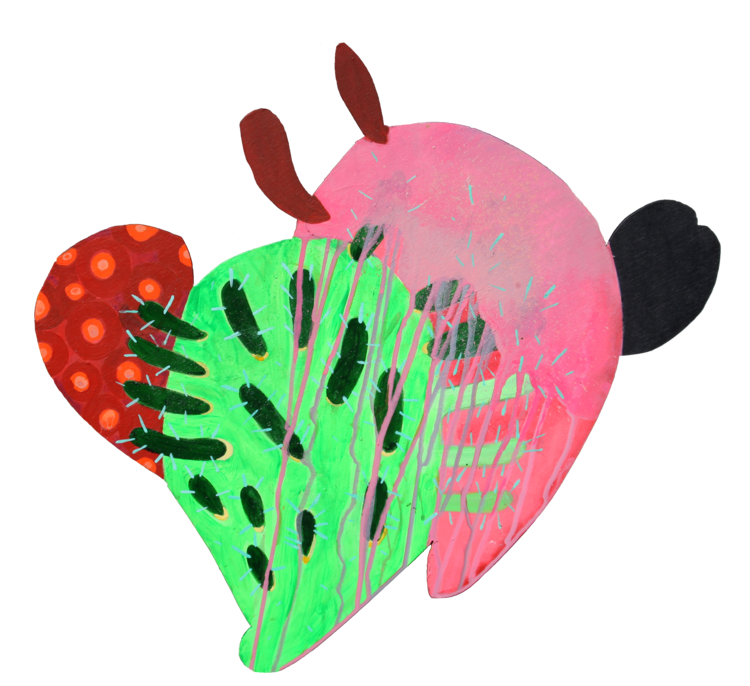
Velentine
“These paintings are directly inspired by the flora of the Sonoran Desert and the patterns found in the natural world. Repetitions unite as they multiply into a visual haiku. Individual shapes are then awakened, synergizing with color and vibrating into pattern. Cactus paddles are combined in compositions that evoke sacred rhythms. Through my art I aspire to gift the observer with a higher vibration of the seen and an elevated sense of the unseen world.”
More
Otherwordly is a series of paintings inspired by cacti, clouds, fungi and sea life. Pulling from every plane of existence, including the cosmic, Otherworldly is the next level of Gjurasic’s work which continually draws inspiration from natural forms. These levitating paintings, which are painted on wood and mounted in a way to cast a sculptural shadow, evoke pop and graffiti movements as well as cartoon and Japanese Kawaii culture, blending with Gjurasic’s urban desert experience in a dynamic and unexpected way.”
to learn more about LEX GJURASIC go to: http://www.lexgjurasic.com/
Manuel Fontes
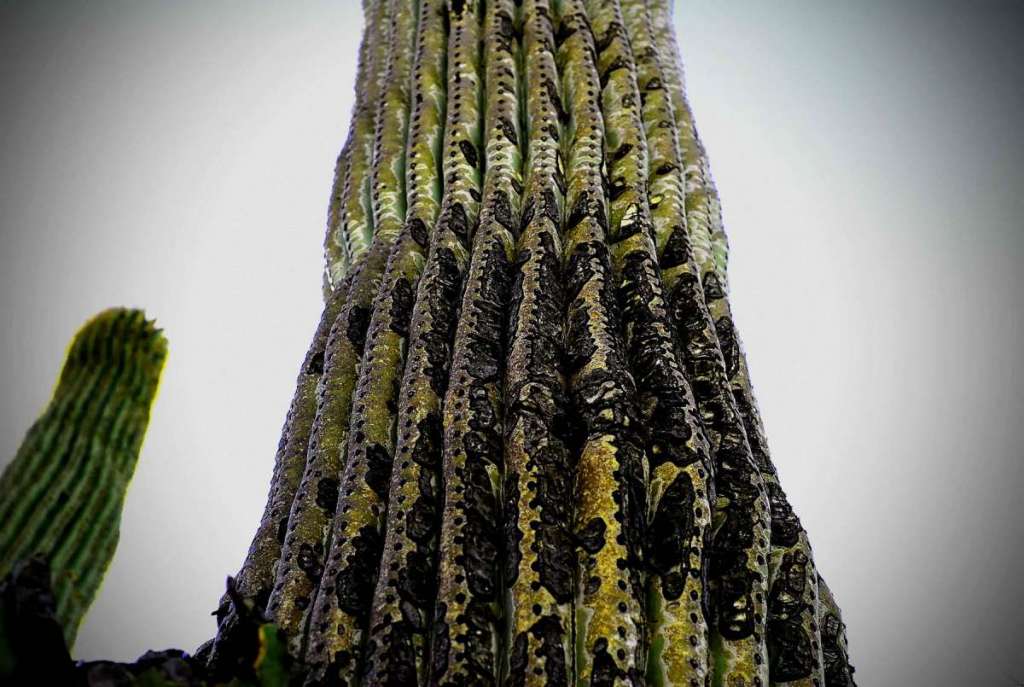
Untitled no. 1
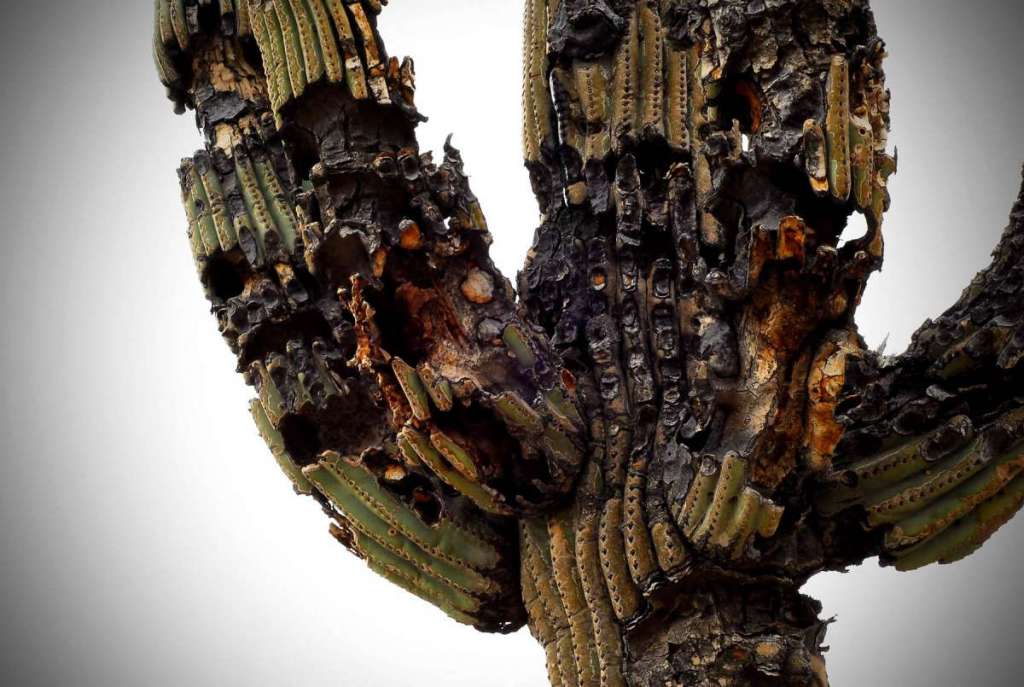
Untitled no. 2
“The Sonoran Desert has always been my home. As an Environmental Scientist I am fascinated by the natural sequence of the Saguaro’s life cycle. Most photographs of the Saguaro depict this beautiful and iconic symbol of the Sonoran Desert in the prime of its life. However, rarely do people ever get to see the Saguaro in its elderly stage of life when disease and finally death completes its
More
life cycle. The final sequence of the Saguaro’s life has a mystery all its own. Its death brings on haunting forms, textures and colors. But not all Saguaro deaths are natural. More and more Saguaros are being lost due to urban encroachment, poaching and climate change. I hope that my photographs will inspire others to protect this wonderful sentry of the Sonoran Desert.”
Stephen Strom
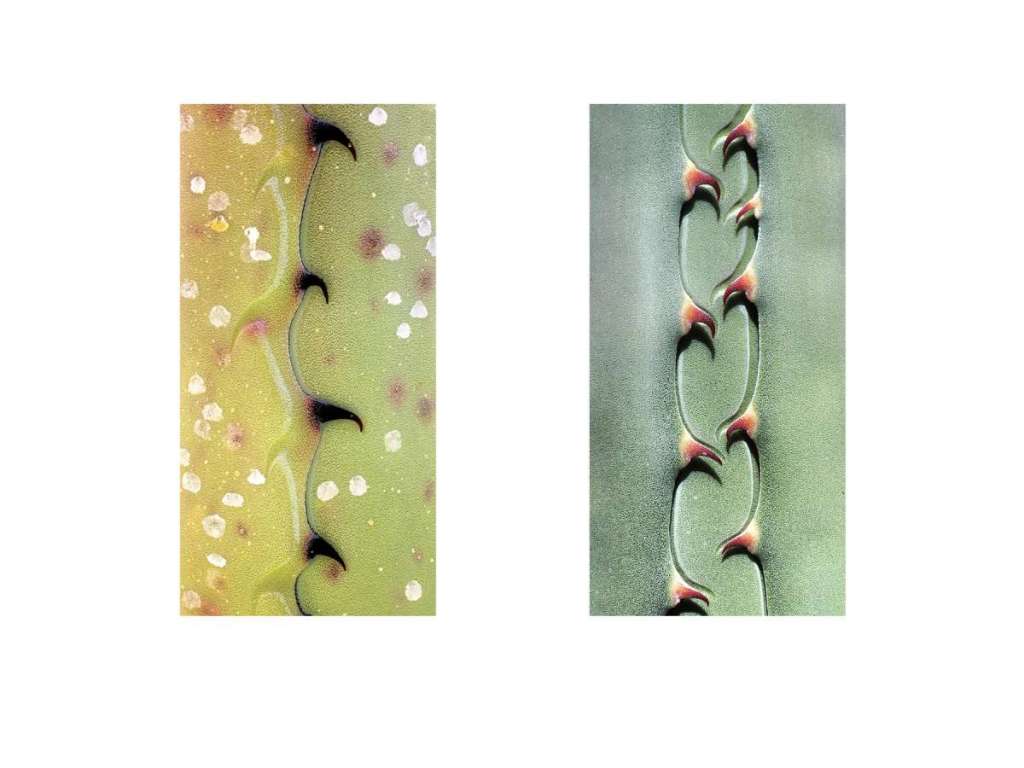
Emerging Agave Stalks I

Emerging Agave Stalks II
“On April 29, 2002, a wildfire ignited south of the Sonoita Valley, a rolling savanna of grass, oak and mesquite in the high Mexican borderlands of southeastern Arizona. Driven by fierce winds, the so-called Ryan Fire eventually consumed nearly 40,000 acres, including more than 80 percent of the Appleton-Whittell Research Ranch, an 8000 acre parcel of
More
magnificent grassland now managed as part of the sanctuary system of the National Audubon Society.
Following the fire, the grounds of the Research Ranch were blackened by ash. Agaves and yuccas were scorched, as were some of the biggest sycamores and cottonwoods on the sanctuary. During May and early June, black dust devils rose from the land, revealing a grassless mars-scape of rocky, red soil.
The photographs in this portfolio were taken in the days, months and yesrs following the Ryan Fire. At first, fire-scarred Agaves provided the only indication of life on the ash-covered hills. I was drawn to photograph them in part to avert my eyes from a scene that could only be called desolate, and in part to create a memorial to a landscape I had grown to love. The transformations of color and shape wrought by the fire created what to my eyes were life-affirming, evocative patterns.
I returned to the Ranch frequently from late April onward, to watch the land, to wait, and to record the slow recovery following the first summer monsoon rains. These images record a transformation and re-emergence that was at once natural and miraculous”
to learn more about STEPHEN STROM go to: https://www.stephenstrom.com/
Tamara Scott
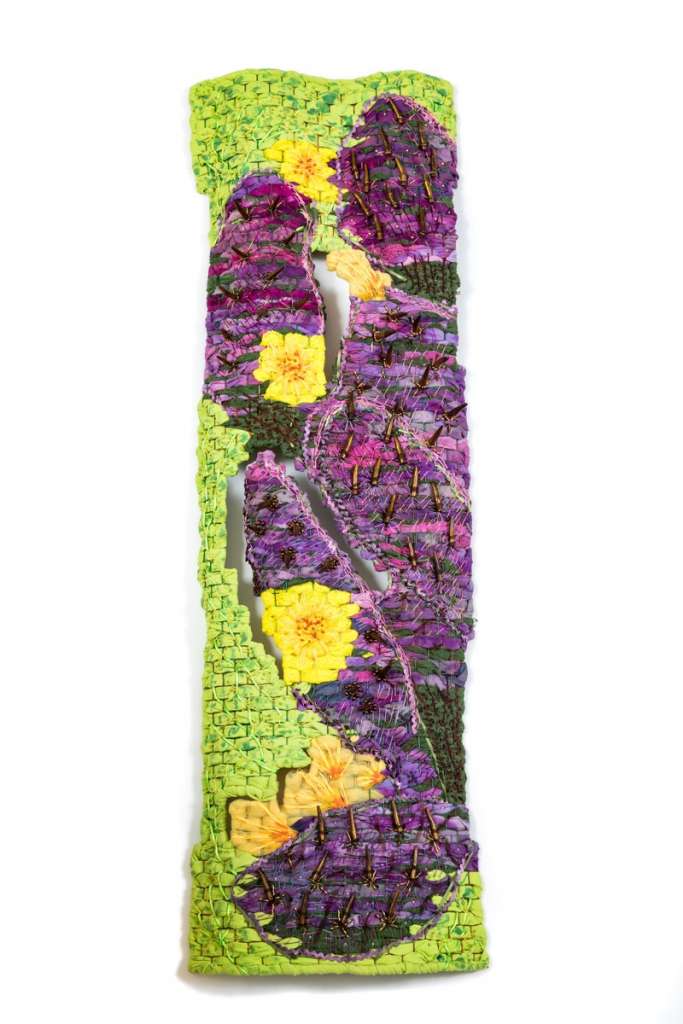
Purple Prickly
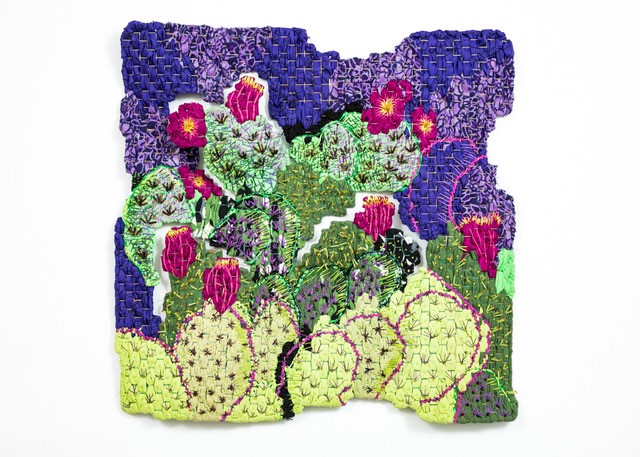
Prickly Pear Patch
“In Prickly Pear Patch, the use of beads and embroidery stitches give the visual and three-dimensional spiny texture to the desert plant.
More
An individual flower of a prickly pear is only in bloom for about 12 hours; however, flowering does not occur all at once. The plants flower for several weeks. A variety of bees feed on pollen and nectar; they climb out from the stamens and up to the stigma where they take off, leaving the flower and depositing pollen as they go. Because the bees are visiting numerous flowers in a single flight and the flowers they visit are protandrous, pollen can be transferred from one flower to another and self-pollination can be avoided.”
“Purple Prickly was inspired by the Santa-Rita prickly pear (Opuntia violacea var. santa rita). The color contrast of their blue-grey pads and the shades of purple make it one of the most colorful of the prickly pear cacti.
Both the pads and fruit are edible. Cold temperature and drought intensify the purple color. Lovely yellow flowers appear in the spring followed by red fruit in the summer months. Inspired by the colors and textures of the flora of my surroundings, flowers and plant life are a favorite subject of mine. I enjoy layering fabrics, ribbons, trim, thread and beads to depict real and imaginative flowers.”
to learn more about TAMRA SCOTT-ANDERSON go to: https://www.tamaraartist.com/
Colleen Quigley
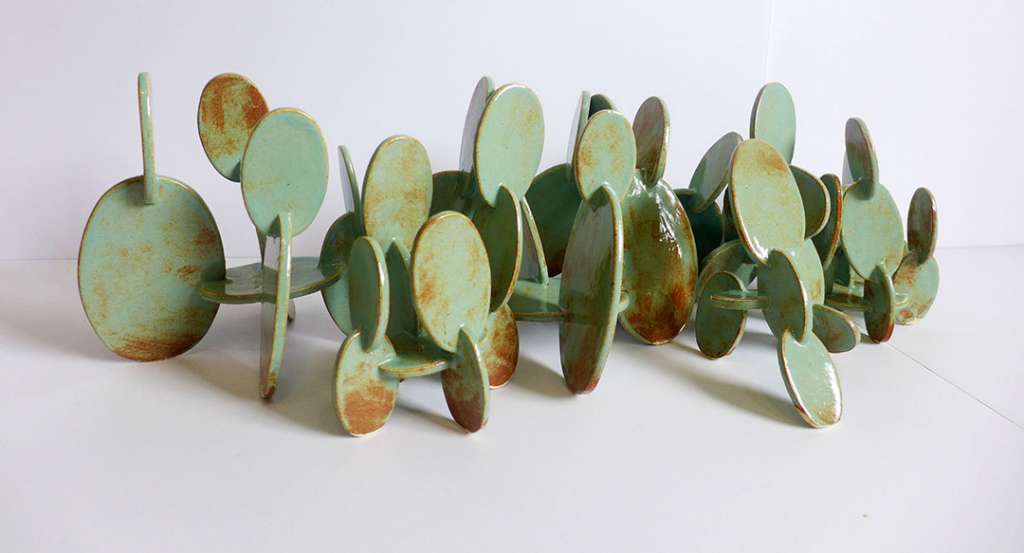
Propagating Pop Cacti
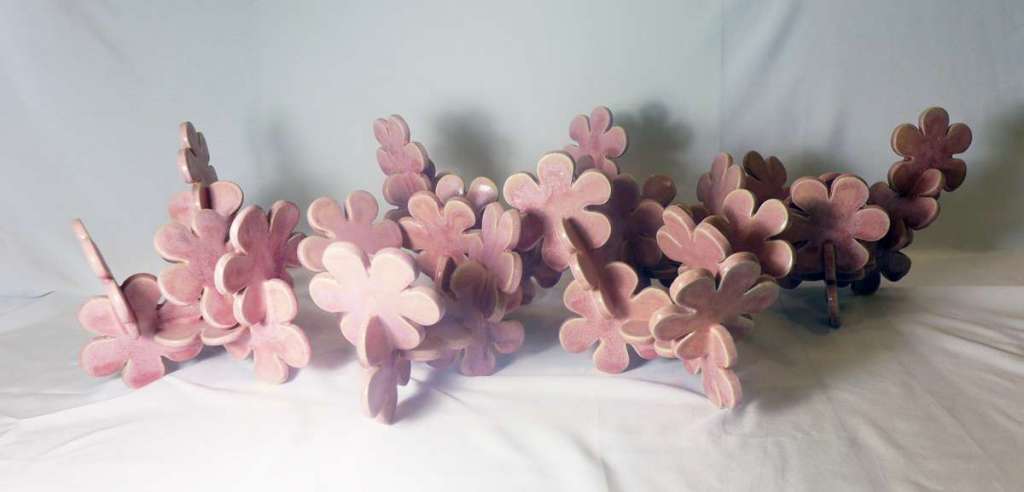
Pink Arcadia
“Pink Arcadia is a grouping of hybrid forms covered in a pink glaze inspired by the multiplicity of shapes and colors of cacti native to the Sonoran Desert. The arrangement of the pieces evoke propagation and repetition, a dynamic that highlights the potential of basic forms. The pink glaze evokes an idyllic space of unbounded colorful nature, a pink arcadia.”
More
“Propagating Pop Cacti evokes the movement and shapes of plant life found in the Sonoran Desert landscape. Working with clay, a malleable medium that allows creative transformations, this piece suggests multiple pollinations while leading us to imagine a diverse, wondrous world full of possibilities.”
to learn more about COLLEEN QUIGLEY go to: https://www.colleenquigleyart.com/
Christopher Allison
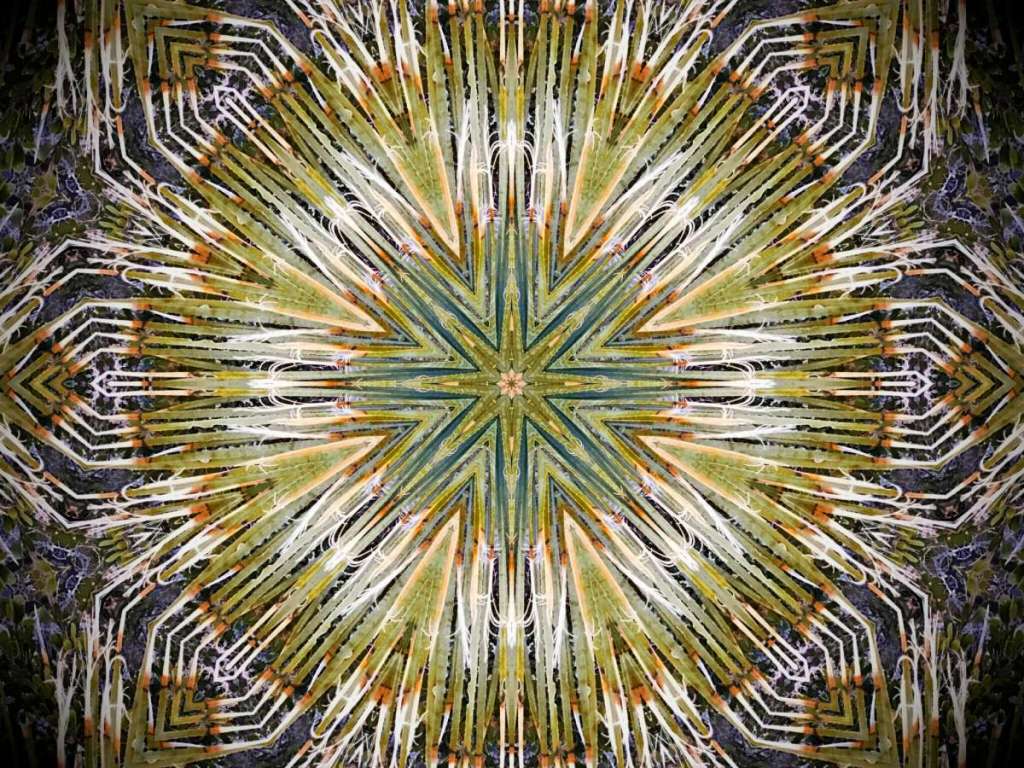
Uncommon Sotol
“Common Sotol (Dasylirion wheeleri) is abundant in the Upper Sonoran life zone of Molino Canyon. The long, radiating, toothed leaves of this plant frequently end in a frayed and fibrous curl. Flowering stems dot the landscape long after the flowers have faded. Once a Common Sotol dies and begins to disintegrate, piles of golden brown leaves with a spoon-like base surround the fallen flowering stem.”
Teresa Wertheimer
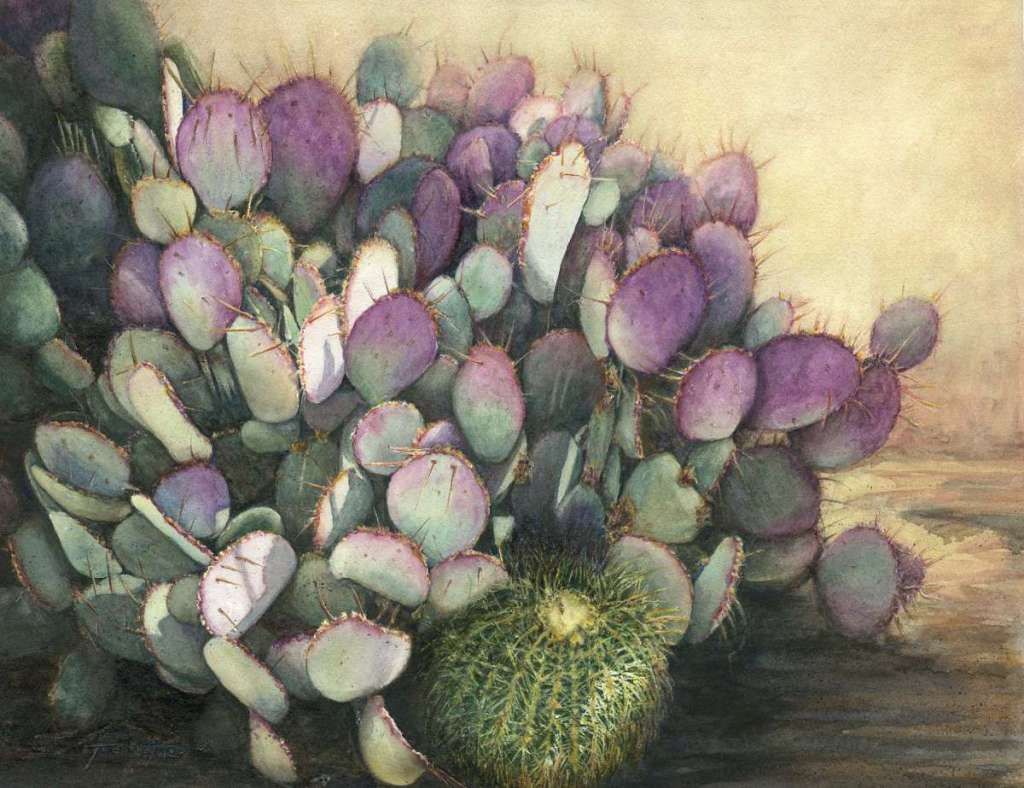
Purple Prickly Pear
“The genus “Opuntia” includes all of the prickly pear cacti. These cacti have been a staple of the Sonoran diet for thousands of years and virtually all of the plant is edible. Its well-known “pears” are sweet and are used as you would a fruit (drinks, jams, etc.) and the pads, or “nopales”, are cooked and used as a vegetable. Even the petals of the blossoms can be eaten in a salad and can make it a very elegant dish indeed!”
James Cowlin
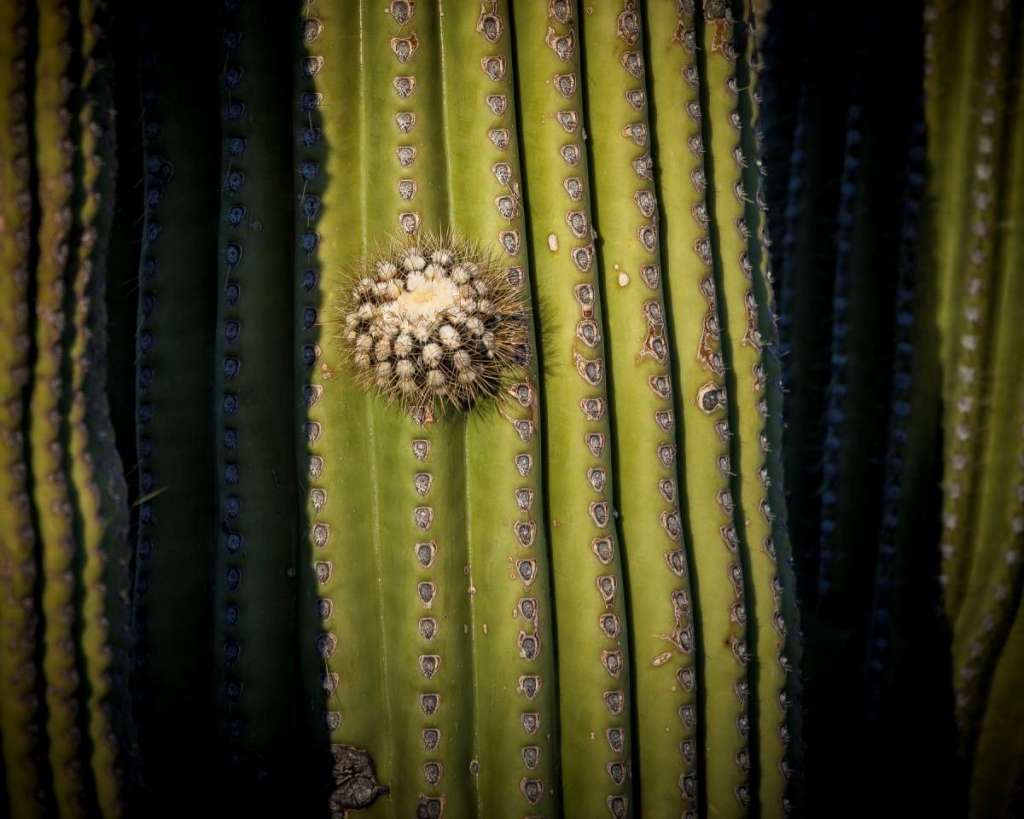
Beginning
“The saguaro cactus is unique to the Sonoran Desert. A saguaro can live to be 200 years old and will start growing arms from the central column when it is 100. This photograph shows the sprout of a new arm—a new beginning for an aging giant.”
to learn more about JAMES COWLIN go to: https://www.jamescowlin.com/index
Todd Ros
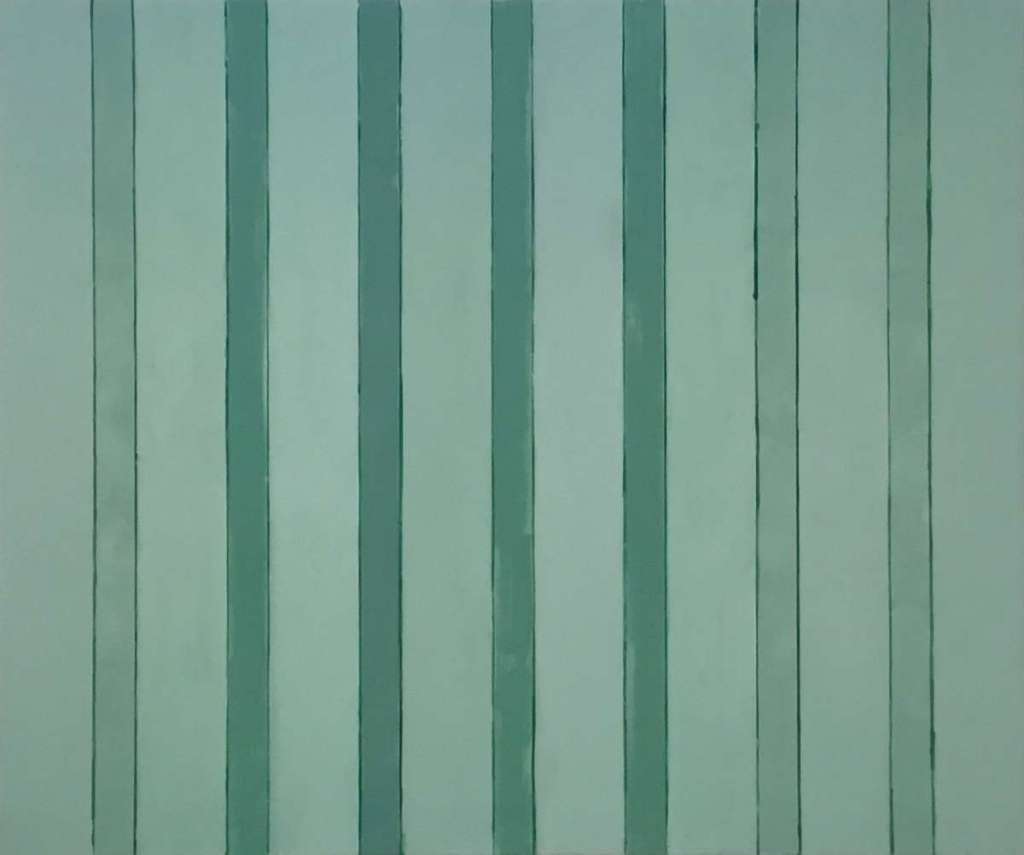
Agave
“I find my subject, more and more, by turning to the nature that surrounds me. In the painting Agave, I was drawn to the unique, almost silvery greens found here in the Sonoran desert. Each new painting starts with a color or set of colors. The subject tends to emerge over time. Having something specific named, gives me a structure to work within. I am interested in the variations that
More
occur through the act of repetition. The act of repeating a line, remixing a color. I want to make a connection and capture the essence of the subject, the essence of nature.”
to learn more about TODD ROS go to: https://www.toddros.com/
Tom Baumgartner

Ocotillix Rosario
“In between rains, an ocotillo dials its metabolism down to a crawl and appears to be a bundle of dead, spiny sticks. When rains occurs, it springs into action by sprouting leaves and bright red, torch-like blooms. Pollinators like carpenter bees and hummingbirds are attracted to the blooms.
Rebecca Bish
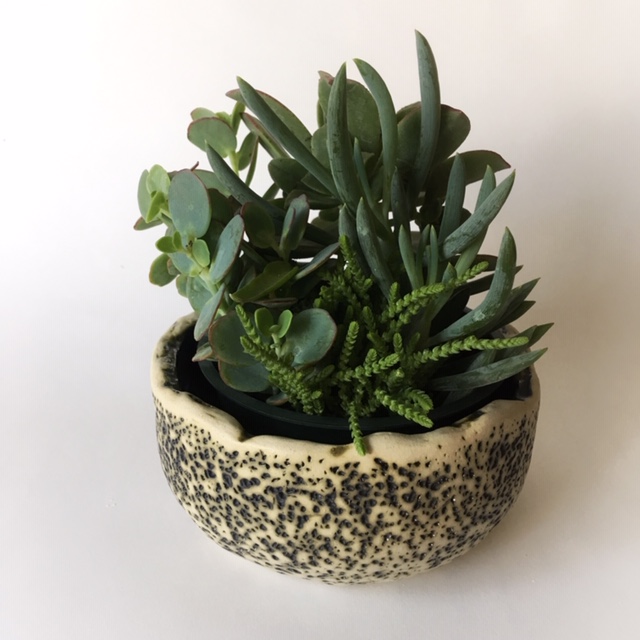
Succulent Planter
“In all of my work, I seek to express a sense of reverence for nature – to recognize what is sacred in even the simplest of natural forms. As an artist, I am not interested in idealized or perfected beauty, but am more drawn to the seemingly disordered and chaotic aspects of nature. The tangled thickets, weathered branches, and exposed tree roots that comprise much of the desert terrain all serve as inspiration for my sculptural clay work.”
Ruben Urrea Moreno
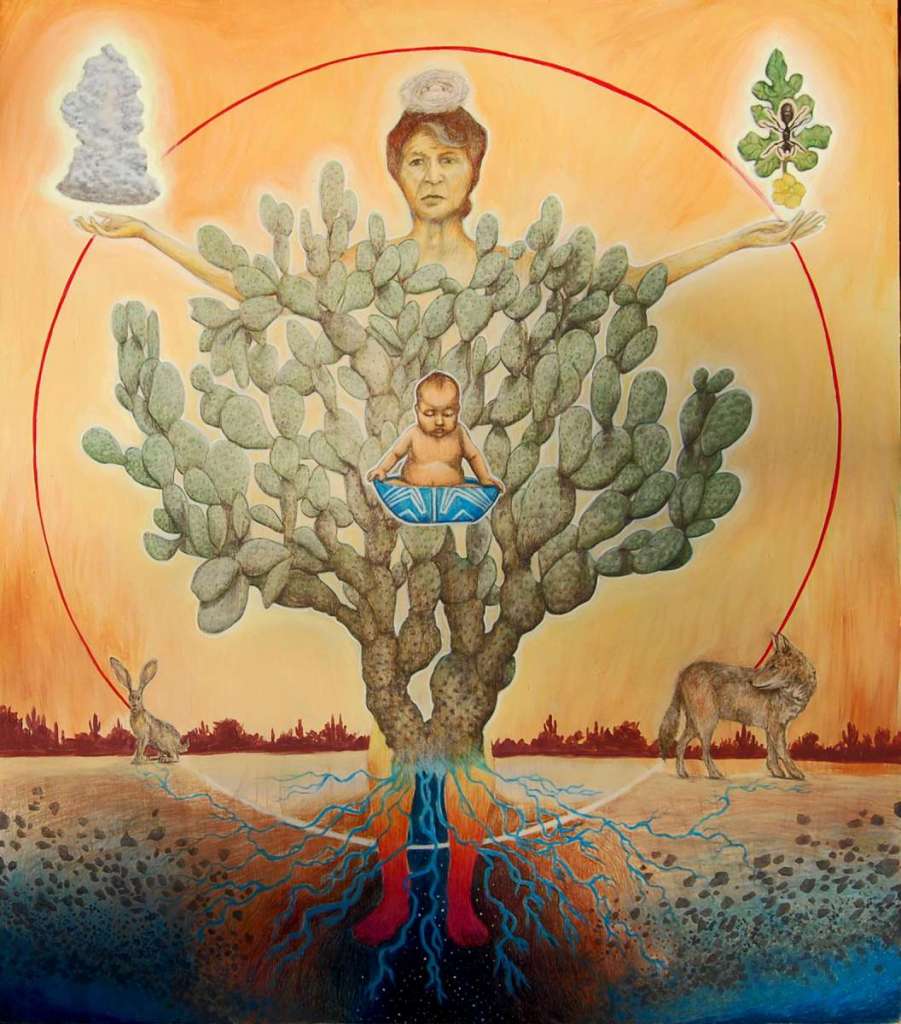
Mother Nopal
“Precarious is the path of water in the desert: a thirst that’s carefully balanced on a complex system of events between the landscape and its inhabitants. Mother Nopal steadily watches over this process, carefully conserving her energy. She watches the ants below, how they mark their trails to food, and how they carve their tunnels while aerating the earth. She sees how this helps her when the rains
More
come: she feels how the rain better reaches her roots and how it seeps deeper into the dry soil. Together with the hormigas they map the path of the rain and she shows her gratitude by reaching to the sun, blooming flowers, sprouting fruits and offering her gifts of nourishment for all who will come.”
to learn more about RUBEN URREA MORENO go to: http://rubenurreamoreno1111.blogspot.com/
Sandra Luehrsen
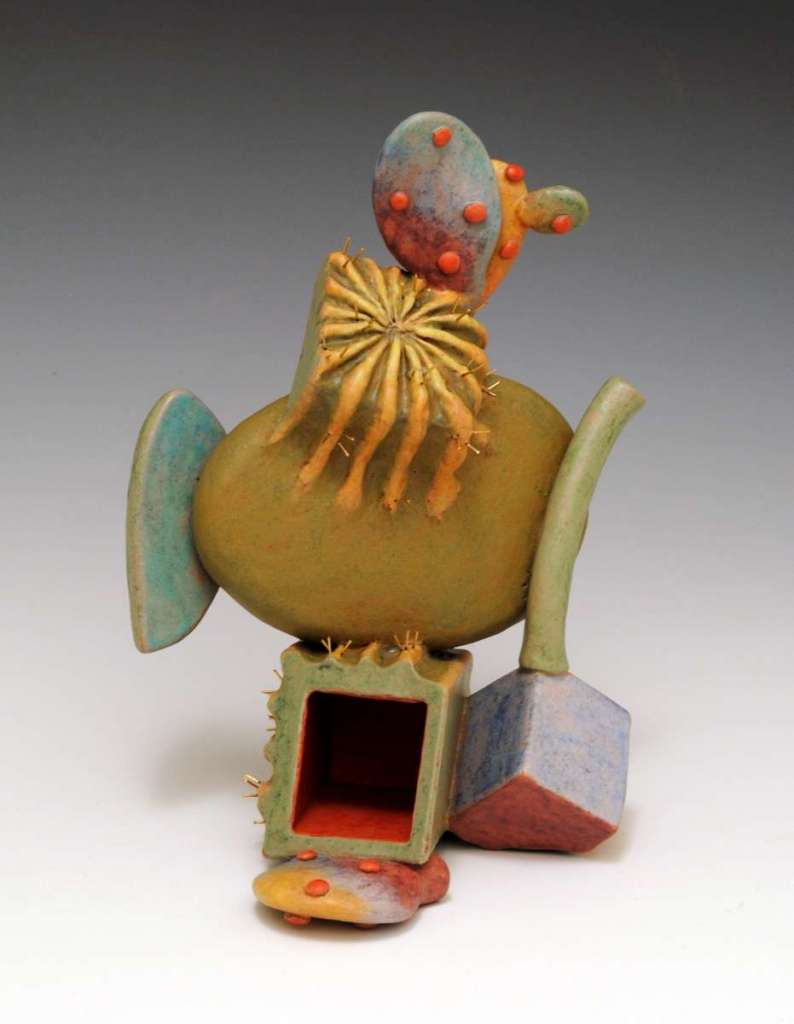
Tree of Life
“I came from Chicago to this wild place, Arizona, for a new beginning. I didn’t expect it but the exotic flora fascinated me right from the start. Inspired by the desert, I use clay to create my own hybrids. These sculptures have container and plant components. The container becomes the plant and the plant the container – a two-way metamorphosis.
More
Long used for making food vessels, the clay itself seems to deliver sustenance. The plasticity of wet clay easily allows the expression of growth. The material itself exudes a life force.
I use red earthenware clay. Each sculpture goes through multiple firings–a bisque firing at 1987° F (cone 03); two or more glaze firings at 1828° F (cone 06); and, for some works, ceramic transfer or metallic luster firings at 1360° or 1252° F respectively (cone 017 or 019). I make a boron-based creamy matte glaze with raw materials and add ceramic stains for color. I also fire nichrome (i.e., kiln element) wire into the sculpture and apply gold or copper metallic luster to it.”
to learn more about SANDRA LUEHRSEN go to: https://sluehrstudios.com/
Amanda Rorhbach
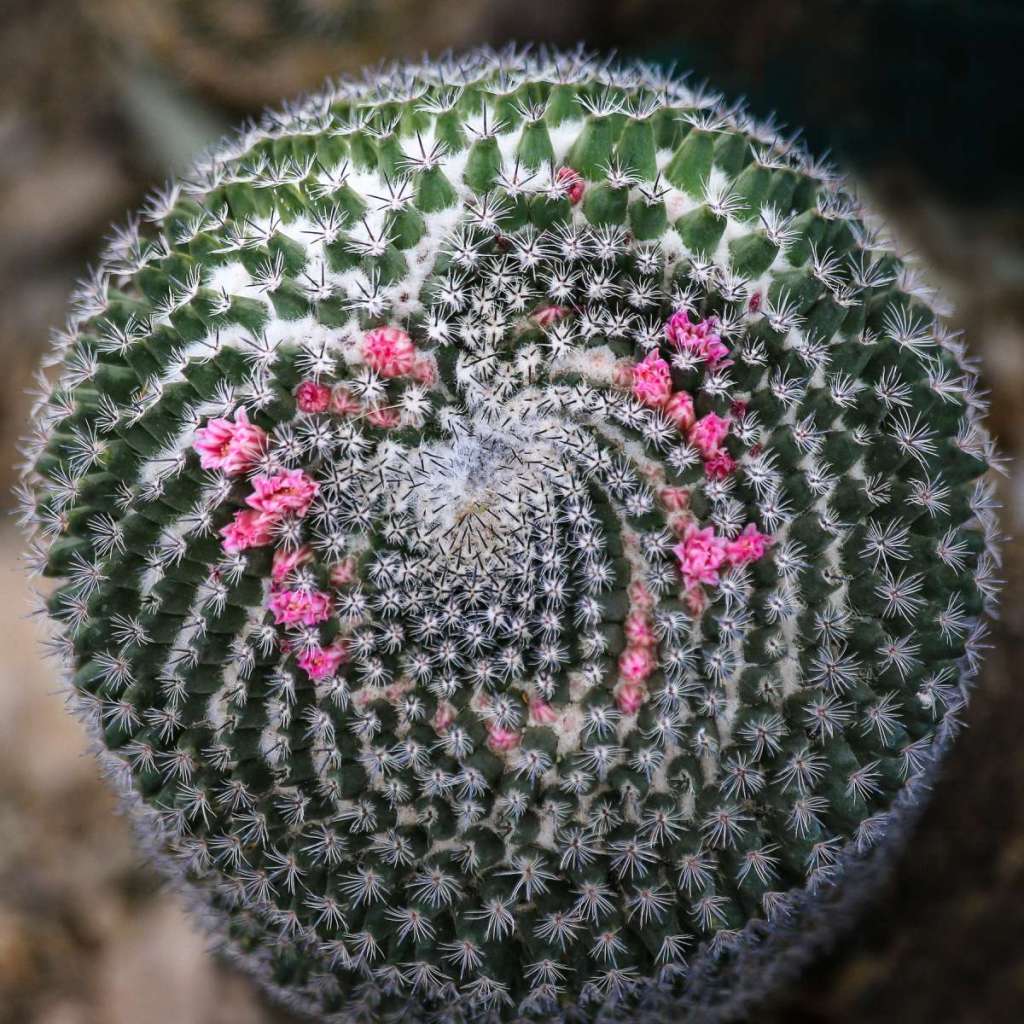
Spiral Galaxy
“The elegance and symmetry of spirals are found many places in nature – this small cactus curls around like a spiral galaxy in miniature, its bright blooms springing open like supernovae.”
Mary Johns
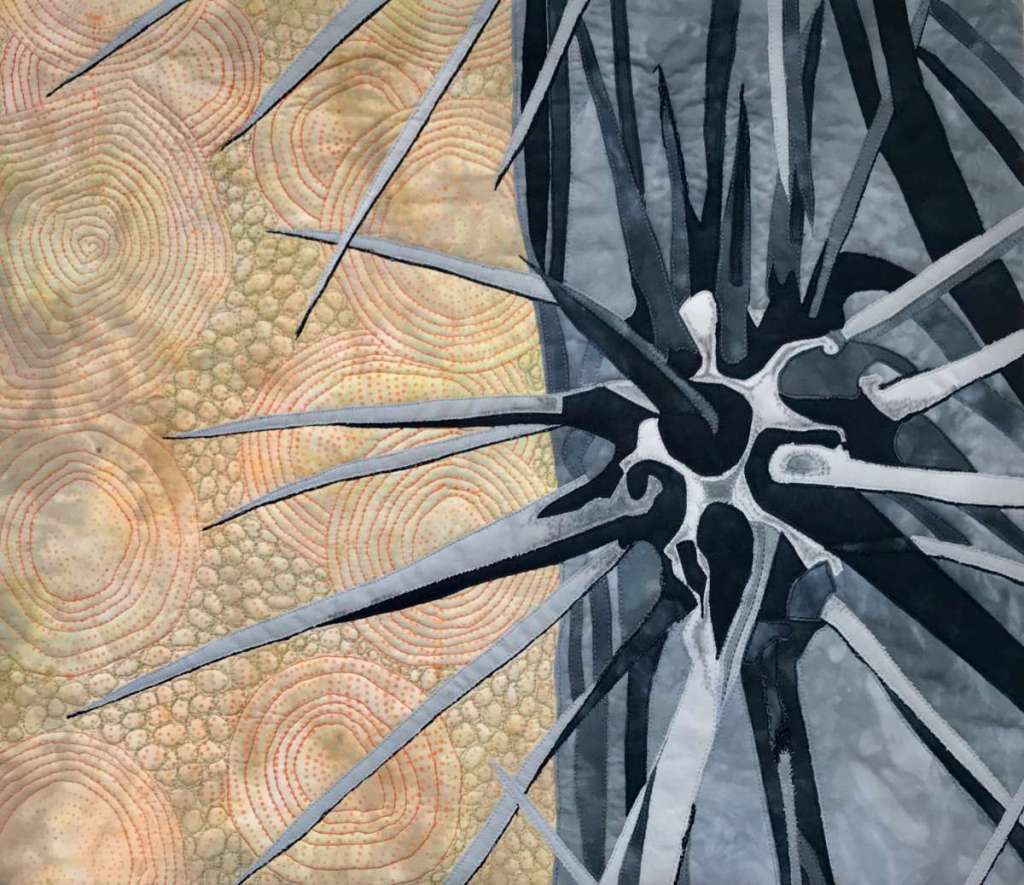
One Saguaro Areole with Spines
“I find the minute detail of the geometry of a saguaro areole Otherworldly. It begs me to pause and delight in the wonder of our symbol of Arizona.”
Lyn Hart

nopalita violeta
“Santa Rita prickly pears (Opuntia violaceae santa rita) display decidedly un-cactus-like hues of red-violet, blue-violet, and bluish-green. A Sonoran desert cactus that is both indigenous and commonly used in urban xeriscapes, it creates jumbled sprawling masses of paddles that shelter many desert creatures. In spring, their
More
luminously shocking greenish-yellow blooms burst forth, revealing another aspect of their unusual beauty.”
to learn more about lyn hart go to: http://www.desertsongstudio.com/
Mary Rogot
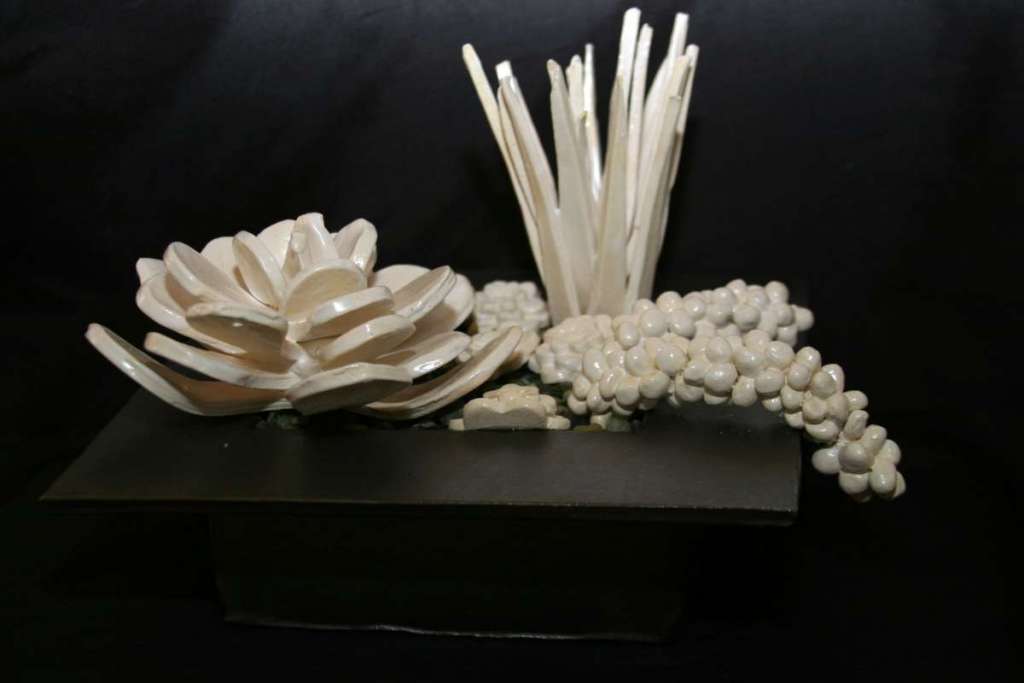
Succulent Garden
“It is easy to be in awe of the giant Sonoran vegetation like the majestic Saguaros, but I found myself being drawn to, and admiring, the smaller plants (e.g., agave) that are able to survive in our environment. I chose to represent the plants in pure white which show off the diversity of their inherent shapes; in addition,
More
the color is evocative of the bleaching property of our Sonoran sun.”
Susan Libby
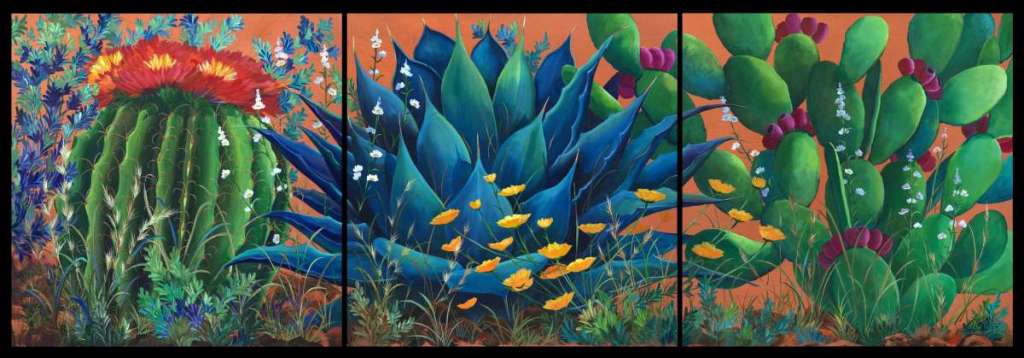
Desert Nectar
“Amidst the desert hills in springtime flow the floral fragrance of cacti, flowers and grasses. This spicy and poignant aroma is the exquisite pollen, a delicacy, which is savored by the industrious pollen gatherers. They flit and fly from one delightful scent to another, creating a diverse and integral pollen path, each plant and gatherer necessary and dependent on one another for the deserts survival.”
to learn more about SUSAN LIBBY go to: http://www.susanlibbyart.com/
Annie Gordon
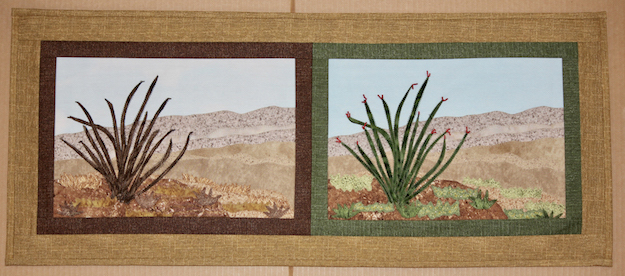
Ocotillo Before and After
“The Ocotillo in its dormant stage is a beautiful cluster of curved and quirky branches that have a stark beauty. They are also one of the most dramatic examples of the effect of any water on desert plants as within seemingly ‘moments’ of rain they sprout petite richly verdant leaves, and then when the blooming season arrives….Oh my!”
to learn more about ANNIE GORDON go to: https://www.etsy.com/shop/AnnieGFabricArt
Robert Renfrow
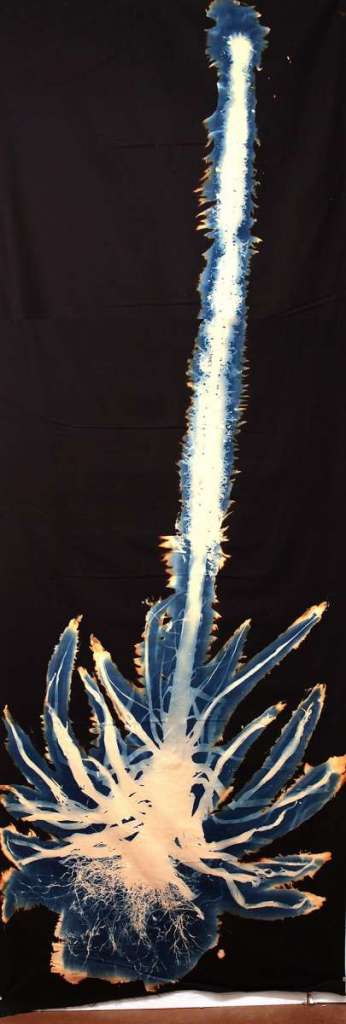
Uprooted Agave
More
“Having spent nearly fifty years of my life exploring the Sonoran desert, I have witnessed many changes over time. Yet, I am also very aware that these fifty years are just a blink of an eye to this ancient, living desert. Many plants, animals and cultures have come and gone before me and many will come after me.
I am an observer of the natural cycles of weather, climate and seasonal life in the Sonoran Desert. Over time, I have seen how human impact on this eco-system affects these processes.
My artwork also involves process- alternative photograph processes which need long periods of time to expose using the ultraviolet light of the desert sun. Often, desert plants are both the subject of a photograph, as well as an object when I utilize the actual plant as a “negative” during this printing process.”
to know more about ROBERT REFROW go to: http://www.robertrenfrow.com/
[/expand]
Day 5 – Weekend Inspiration
Watercolors
Cactus Flower – Drawing Landscape Watercolor
Watercolor Painting Practice Succulent Plants in Watercolors
How to Paint Watercolor Cacti | demonstration
How to Paint Succulents & Cactuses | Watercolor Sketchbook
Succulent Coloring Sheets
The Basics
Coloring Sheets, download by click on the image
[expand title=”MORE COLORING SHEETS” rel=”fiction”]
[/expand]
Next Week’s Theme
